New bike(s) incoming - first ever 2 stroke(s)!
Discussion
Looking for a winter project I always fancied an Indian Papoose - having the largest Indian pennies can buy, I always fancied the smallest.
 the Indian Papoose is actually a Brockhouse Corgi, all made in Southport immediately post war. At that time Brockhouse had just acquired the Indian brand name and so all the bikes sent to the US were badged Indian, while the rest of the world got the bikes badged Corgi - but other than the badge and shade of red on the tank the bikes are identical. No real chance of getting a 'real' Papoose in the UK, and the relatively low value of these things would make it pointless importing one. So the plan was to just track down a Corgi, restore it, and badge it as a Papoose...just as a bit of fun for shows, events and the like.
the Indian Papoose is actually a Brockhouse Corgi, all made in Southport immediately post war. At that time Brockhouse had just acquired the Indian brand name and so all the bikes sent to the US were badged Indian, while the rest of the world got the bikes badged Corgi - but other than the badge and shade of red on the tank the bikes are identical. No real chance of getting a 'real' Papoose in the UK, and the relatively low value of these things would make it pointless importing one. So the plan was to just track down a Corgi, restore it, and badge it as a Papoose...just as a bit of fun for shows, events and the like.
The Corgi is often wrongly described as the Paratrooper's bike; that was the Welbike which fitted in a 15" diameter container and was dropped by parachute. There are reports of Welbikes being used in the not-so-successful operation Market Garden and some shown being carried ashore on D-Day. The designer of the Welbike (Lt.Col.Dolphin) designed/launched the Corgi as a primarily a civilian successor, but some were sold to the forces but probably none saw action.
So...I spotted a barn-find one (MK1) and based on what they were going for last year I thought I got a decent price. But it had some missing parts that would have to be made from scratch (no real spares availability) and I did wonder where I could get measurements etc...there is one in the National Motorcycle Museum but that's a long trek for photos and measurements. But as I was googling for parts I spotted a complete and running and road-registered one (MK2) that wasn't selling and so made a very cheeky offer and got it
So now there are two. I'll do a proper restore on the 'good' MK2 and stick Indian badges on it. If I can get the MK1 registered I restore it properly as a civilian Corgi. If I have problems with that I'll paint it Olive Drab and see if I can shift it to some WW2 re-enactors.
Not quite superbikes, but a bit of fun to stick in the back of the car and buzz about ant events and the like, or even to pop up to the shops. And I gather Castrol R is OK to use as the pre-mix in old 2-strokes
Neat period video
https://www.youtube.com/watch?v=EONV--eWKPQ
The new additions to the tribe
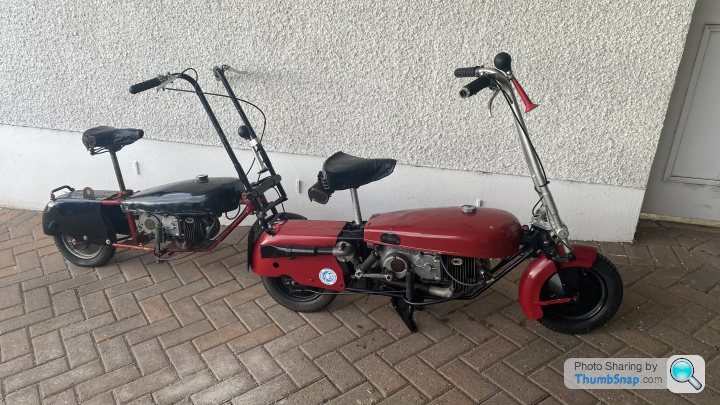
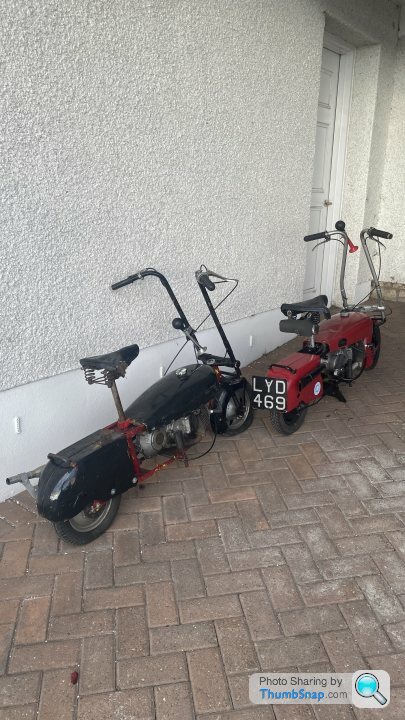
 the Indian Papoose is actually a Brockhouse Corgi, all made in Southport immediately post war. At that time Brockhouse had just acquired the Indian brand name and so all the bikes sent to the US were badged Indian, while the rest of the world got the bikes badged Corgi - but other than the badge and shade of red on the tank the bikes are identical. No real chance of getting a 'real' Papoose in the UK, and the relatively low value of these things would make it pointless importing one. So the plan was to just track down a Corgi, restore it, and badge it as a Papoose...just as a bit of fun for shows, events and the like.
the Indian Papoose is actually a Brockhouse Corgi, all made in Southport immediately post war. At that time Brockhouse had just acquired the Indian brand name and so all the bikes sent to the US were badged Indian, while the rest of the world got the bikes badged Corgi - but other than the badge and shade of red on the tank the bikes are identical. No real chance of getting a 'real' Papoose in the UK, and the relatively low value of these things would make it pointless importing one. So the plan was to just track down a Corgi, restore it, and badge it as a Papoose...just as a bit of fun for shows, events and the like.The Corgi is often wrongly described as the Paratrooper's bike; that was the Welbike which fitted in a 15" diameter container and was dropped by parachute. There are reports of Welbikes being used in the not-so-successful operation Market Garden and some shown being carried ashore on D-Day. The designer of the Welbike (Lt.Col.Dolphin) designed/launched the Corgi as a primarily a civilian successor, but some were sold to the forces but probably none saw action.
So...I spotted a barn-find one (MK1) and based on what they were going for last year I thought I got a decent price. But it had some missing parts that would have to be made from scratch (no real spares availability) and I did wonder where I could get measurements etc...there is one in the National Motorcycle Museum but that's a long trek for photos and measurements. But as I was googling for parts I spotted a complete and running and road-registered one (MK2) that wasn't selling and so made a very cheeky offer and got it

So now there are two. I'll do a proper restore on the 'good' MK2 and stick Indian badges on it. If I can get the MK1 registered I restore it properly as a civilian Corgi. If I have problems with that I'll paint it Olive Drab and see if I can shift it to some WW2 re-enactors.
Not quite superbikes, but a bit of fun to stick in the back of the car and buzz about ant events and the like, or even to pop up to the shops. And I gather Castrol R is OK to use as the pre-mix in old 2-strokes

Neat period video
https://www.youtube.com/watch?v=EONV--eWKPQ
The new additions to the tribe


An update for anyone interested - the Mk2 (red tank) is/was in much better condition that I expected with pretty much everything there apart from the headlamp, tail lamp and front numberplate - but I've tracked these down. I've got a copy of the original registration (although built in 1949 it wasn't registered until 1950) and it's on the original plate - LYD469; so henceforth it will be Lydia.
Unbent the handlebars and got all the folding stuff working again and put on new tyres - I think the front was original. Wheel bearings are bicycle-style cup and cone and the fronts seemed OK with just new ball bearings but the rears were totally shagged out with the cones worn away. With spares non-existent I decided to swap to modern sealed bearings - just needed a spacer tube thingy and turned-down the axle a bit and it's all right as rain with a few other spacers to get things lied up. My idea was just to get running before doing any proper restoration, but the rear sprocket and locknut had loads of thick paint I couldn't budge (old Hammerite I think) so I ran it up on the lathe so at least the sprocket is shiny now. Got the steering head lubed up and adjusted, got the brakes functional again, cleaned out the carb and got the kick-start and clutch working again.
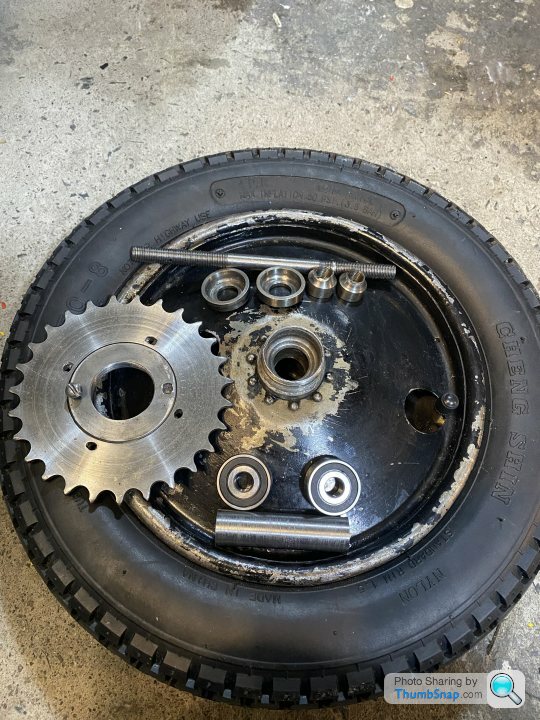
New tyre, conversion to sealed bearings and a shiny sprocket
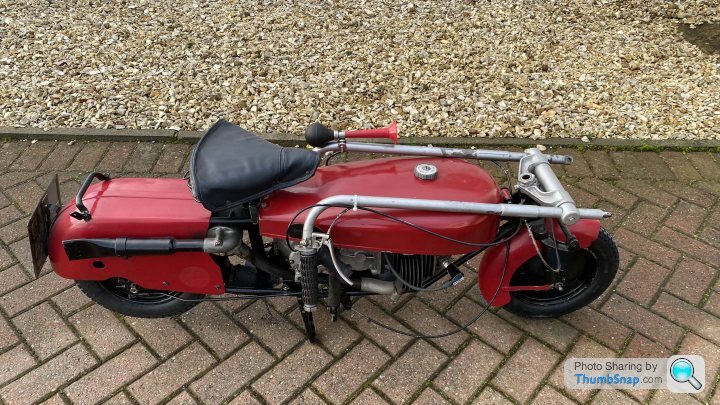
All folds down now, sits on a newly functional stand, and everything works so pretty much in 'oily rag' condition.
And proof it does actually run - I managed to get it fired-up and out on the road today. It's quite good fun - there's no gearbox so no neutral, just a clutch. But the MK2s added the luxury of a kick start, and so to stop the bike moving forward when kicked-over there's a sliding dog on the engine sprocket that operates off the right-side footrest being folded up. So once it's fired-up you pull in the clutch and drop the footrest to engage and off you go
Video from today
https://www.youtube.com/watch?v=Ctb-t55TLcw
So it's now quite usable, but I will now start to restore it as the's bashes in the tank/mudguards and a selection of shades of red...but while I thought I might have to repaint the frame I think it's original paint and it looks not bad so I'll leave that.
But the other one is not such a happy tale - it's a total shed with many missing parts (the whole rear brake mechanisn), stand, lights, inner mudguard, chainguard, etc etc; wrong parts like wrong carburettor (but I think I've tracked down one that's correct apart from the jetting), wrong exhaust, wrong levers etc...and the tinware is in a hell of a state. And bodge central - someone had fitted inner tubes without the curved valve stems so they'd just beaten-hell out the wheel disks to get a regular airline in. Best of all is the steering head - instead of the nuts (and bearings!) there was a washer and they'd drilled the stem for a spilt-pin (and buggered the threads). 'kin'ell - who would do that sort of thing? So it's a real Frankenstein's monster; so I shall call it Frankie, to go with Lydia.
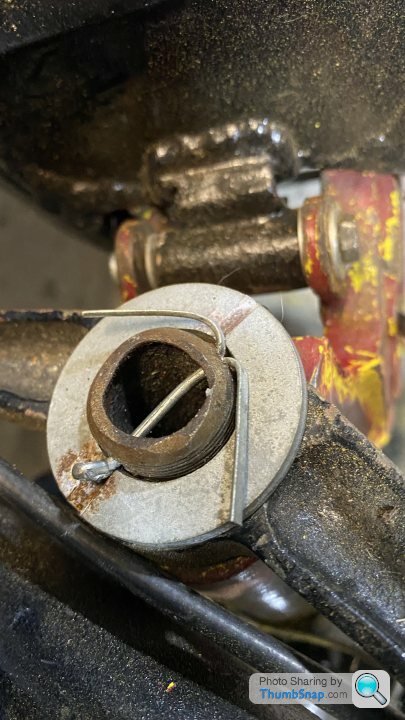
But as I've been sorting things out with Lydia, if the part I've taken off is missing from Frankie I've been making copies. The first was the kick stand toggle bracket. I had a sheet of steel that I've had for years - it's been used for all sorts of things, most notably the engine mounts to get the LS7 into the Tuscan. I didn't have any steel bar, but I did have a big bolt...
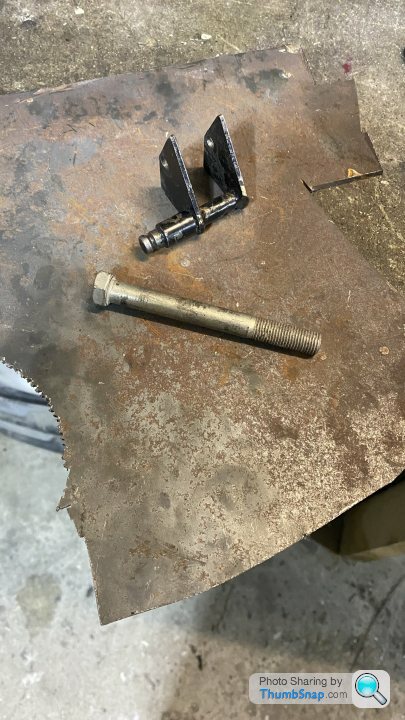
...and there we have the first new part for Frankie.
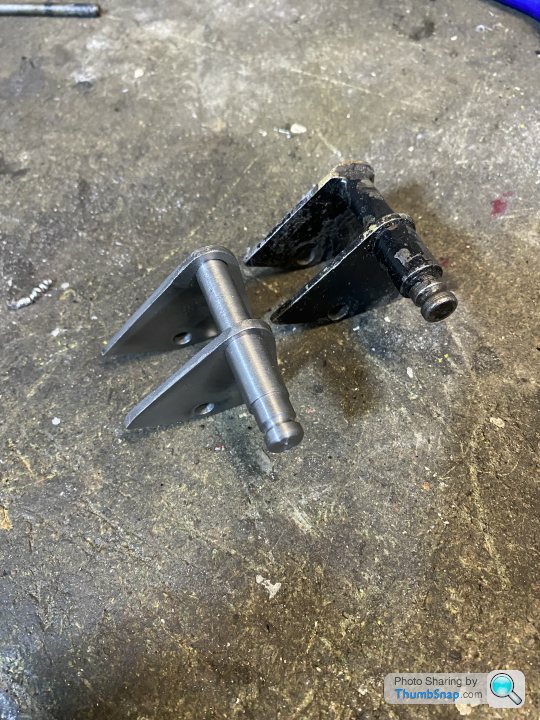
It begins
Not a patch on some of the skilled/quality work I've seen on here from others, but I'll post some more updates once I get some substantial progress under my belt.
Unbent the handlebars and got all the folding stuff working again and put on new tyres - I think the front was original. Wheel bearings are bicycle-style cup and cone and the fronts seemed OK with just new ball bearings but the rears were totally shagged out with the cones worn away. With spares non-existent I decided to swap to modern sealed bearings - just needed a spacer tube thingy and turned-down the axle a bit and it's all right as rain with a few other spacers to get things lied up. My idea was just to get running before doing any proper restoration, but the rear sprocket and locknut had loads of thick paint I couldn't budge (old Hammerite I think) so I ran it up on the lathe so at least the sprocket is shiny now. Got the steering head lubed up and adjusted, got the brakes functional again, cleaned out the carb and got the kick-start and clutch working again.

New tyre, conversion to sealed bearings and a shiny sprocket


All folds down now, sits on a newly functional stand, and everything works so pretty much in 'oily rag' condition.
And proof it does actually run - I managed to get it fired-up and out on the road today. It's quite good fun - there's no gearbox so no neutral, just a clutch. But the MK2s added the luxury of a kick start, and so to stop the bike moving forward when kicked-over there's a sliding dog on the engine sprocket that operates off the right-side footrest being folded up. So once it's fired-up you pull in the clutch and drop the footrest to engage and off you go

Video from today
https://www.youtube.com/watch?v=Ctb-t55TLcw
So it's now quite usable, but I will now start to restore it as the's bashes in the tank/mudguards and a selection of shades of red...but while I thought I might have to repaint the frame I think it's original paint and it looks not bad so I'll leave that.
But the other one is not such a happy tale - it's a total shed with many missing parts (the whole rear brake mechanisn), stand, lights, inner mudguard, chainguard, etc etc; wrong parts like wrong carburettor (but I think I've tracked down one that's correct apart from the jetting), wrong exhaust, wrong levers etc...and the tinware is in a hell of a state. And bodge central - someone had fitted inner tubes without the curved valve stems so they'd just beaten-hell out the wheel disks to get a regular airline in. Best of all is the steering head - instead of the nuts (and bearings!) there was a washer and they'd drilled the stem for a spilt-pin (and buggered the threads). 'kin'ell - who would do that sort of thing? So it's a real Frankenstein's monster; so I shall call it Frankie, to go with Lydia.

But as I've been sorting things out with Lydia, if the part I've taken off is missing from Frankie I've been making copies. The first was the kick stand toggle bracket. I had a sheet of steel that I've had for years - it's been used for all sorts of things, most notably the engine mounts to get the LS7 into the Tuscan. I didn't have any steel bar, but I did have a big bolt...

...and there we have the first new part for Frankie.

It begins

Not a patch on some of the skilled/quality work I've seen on here from others, but I'll post some more updates once I get some substantial progress under my belt.
I'm not so good at taking regular pictures or posting updates, but I've reached a milestone and so here's a wee update. On the way through rebuilding Lydia I made some of the missing parts for Frankie. Easy enough to turn the locking pin for the seat post in the lathe, but the spring was another matter. While doing the weekly shop (guess where!) I noticed spatulas were springy so I bought a couple to experiment with...which was cheaper than buying a length of spring steel off eBay or wherever. Bending cold just snaps the metal, and heating to bend removes the springyness. But with the aid of a few YouTube videos on how to temper spring steel ('blue' it and quench it) I ended up with a passable pin and spring - mine is on the right. And the reason for the baking tray was I thought it would be thin enough to make the inner mudguard, but once I cut the beading off it was too thin...but I actually tracked down a used (and a bit rusty) inner mudguard anyway.
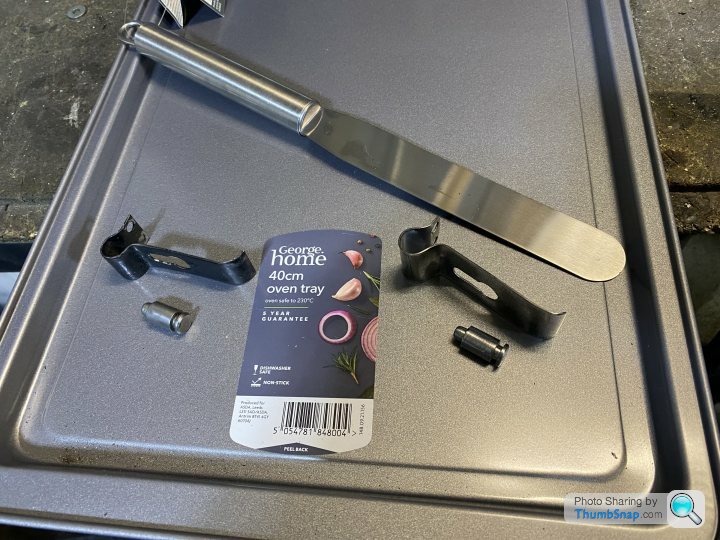
I also managed to track down a headlamp, albeit rusty - I should have taken a proper 'before' picture. But it did have the original Lucas glass intact
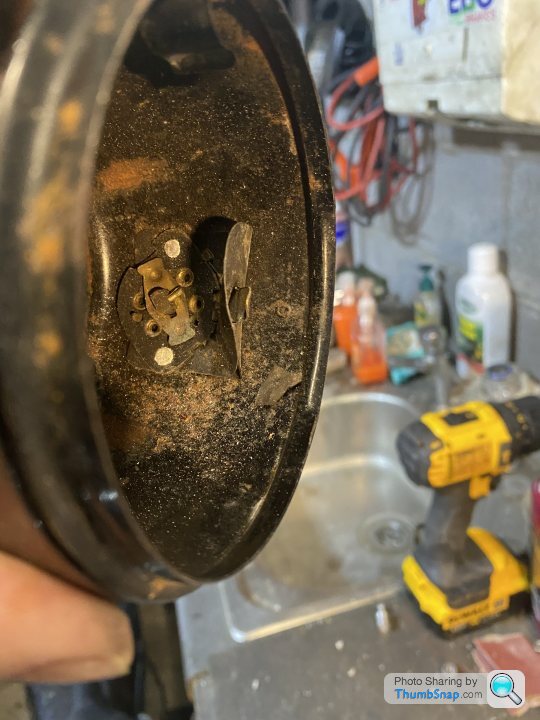
But the rubber mount at the rear was perished and unserviceable.
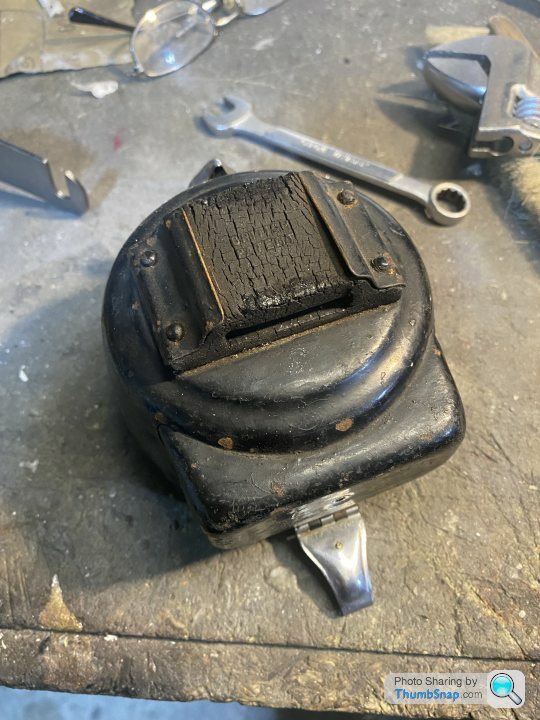
So I cut it out, got some 2-part silicone rubber (and black die), made a wee mould and moulded-on a replacement. When ordering you have to state the hardness you want the finished product and I didn't have a clue...but whatever it is I chose seemed a pretty close match in flexibility to the rubber I expected. Funny stuff to work with though - unlike lots of other 2-part stuff where once the activator/hardner is added the whole lot cures, with this any part of the silicone liquid that hasn't been in direct contact/mix with the hardner doesn't cure so you have to mix it really well. You can see my new 'rubber' mount at the back, plus it cleaned-up pretty well ready for paint.
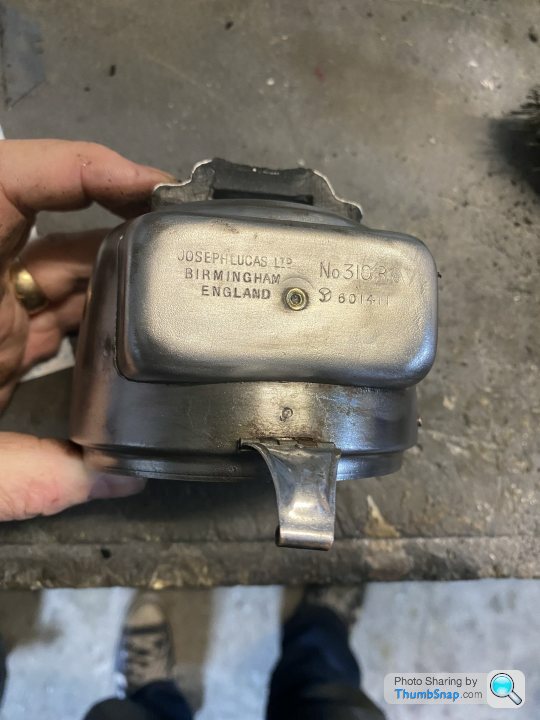
As standard the headlamp (and tail lamp, that I also got hold of and refurbed) are 6 volt off the generator, but the headlamp also should contain a couple of dry-cell batteries that you can switch between generator and batter power for the lights. But a) the battery terminals in the lamp had been eaten away, b) the 2-way switch was shagged and 3) 6v off a crappy generator isn't going to light much. So I put in a 12v rechargeable lithium battery pack (off a house alarm apparently) and reworked the lamps to take 12v LED bulbs and forgot about the generator. The lithium battery will power the lights for as long as I'd be riding it at a time. The finished lamp... I also had to tap-out quite a few dents in the rim and re-polish, but no 'before' pics
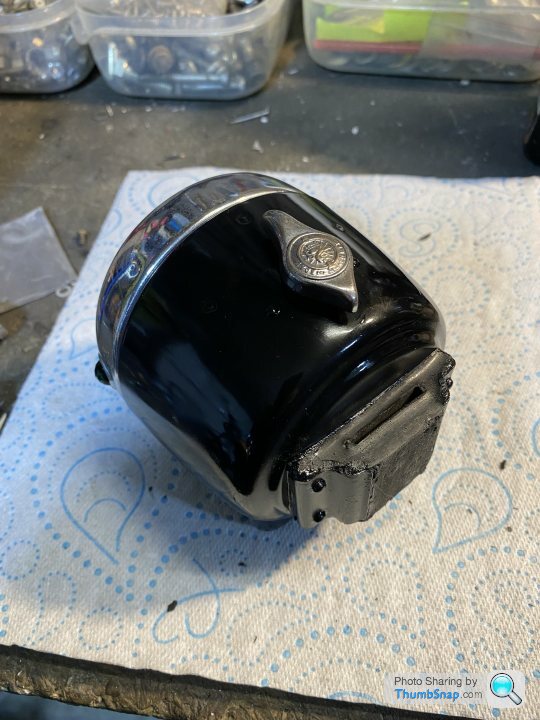
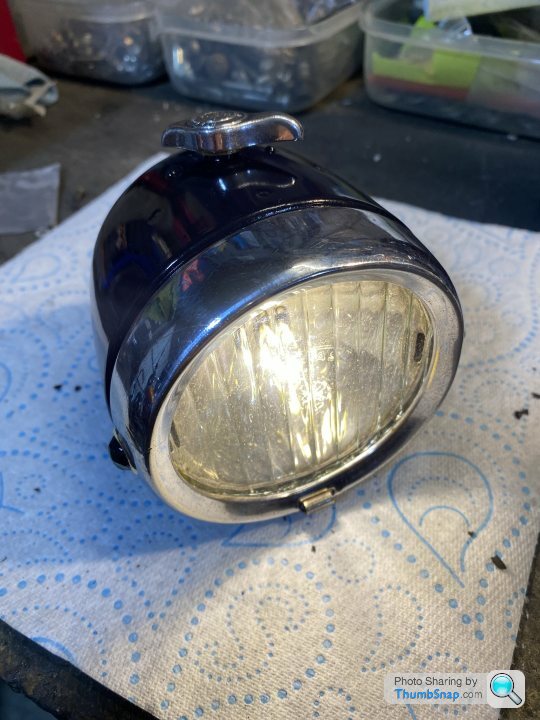
...and I had to make up the brackets etc., but no pics.
The tank didn't look too bad but it did have a few big dents in it. I did try to pull them out with a dent puller, but the metal was too thick to make much of a difference
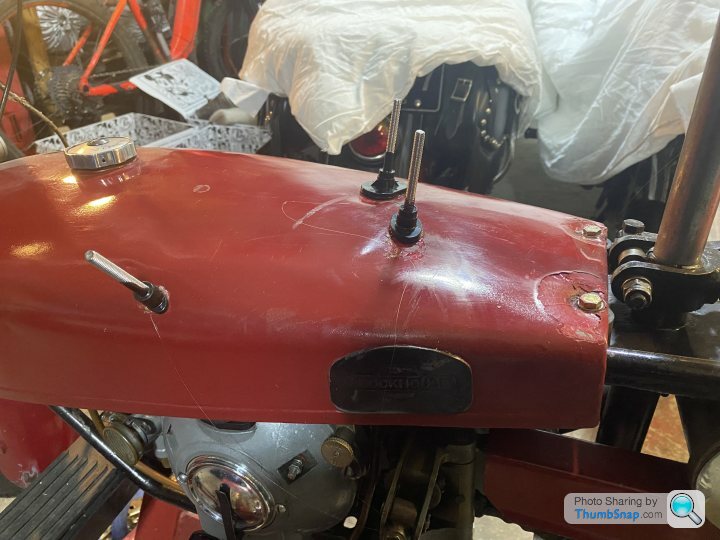
So back to bare metal and filler. I tried to get down to what I thought was the original colour, and it was a bit brighter than the current top-coat. But once I did get down to bare metal (and no photos of this unfortunately) someone had been at the filler before me and it was really in a hell of a state with dents everywhere. No pics of work-in-progress, but it took over a week of a few hours a day filling and rubbing down (and tapping down the high spots) to get it looking like a tank again.
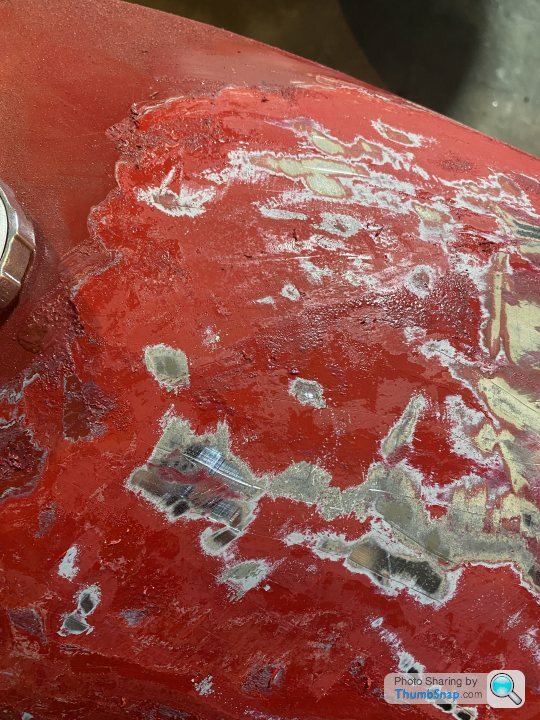
Frankie had no brake lever (amongst many other missing parts) so Lydia's is shown alone with my 'raw materials' - a bit of roll-cage tube a saved off the Tuscan (I keep all sorts of bits of scrap metal!), a rod, and my trusty sheet of mild steel. I bought this years ago as maybe 1/2 a square metre and I've used it for so many things!
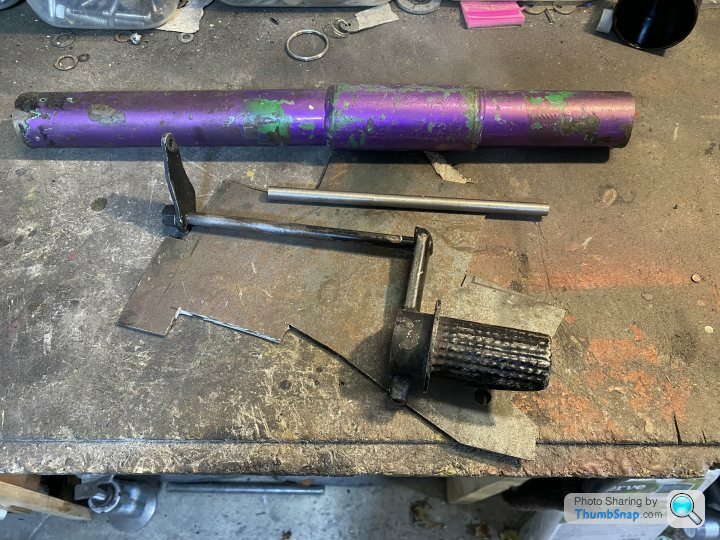
So I cut parts out of the sheet steel, and turned grooves in a section of the tube. And I'd watched an Allen Millyard video of him putting horizontal grooves using the lathe making up hand grips to I copied that.
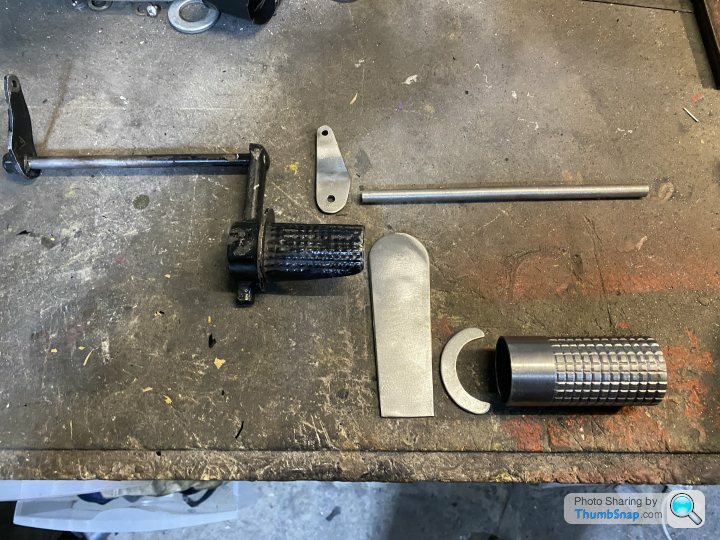
The brake lever arm was probably made originally with a die on a press, but mine was made beating hell out of my sheet steel part with a lump hammer, and then welding up the 'seam' at the curved end.
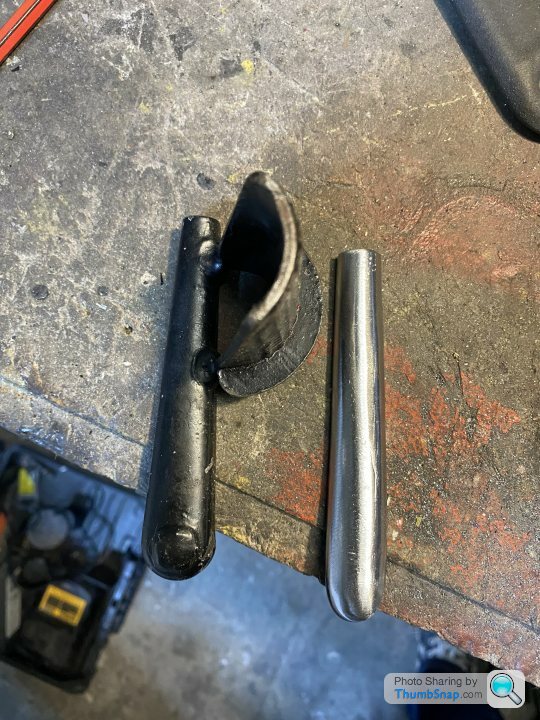
Then all welded-up and painted - my 'fake' lever is on the left, the original from Lydia is on the right. OK, not absolutely identical, I think they must have cast-on the 'treads' on the original, but close enough - a blind-man would be pleased to see it.
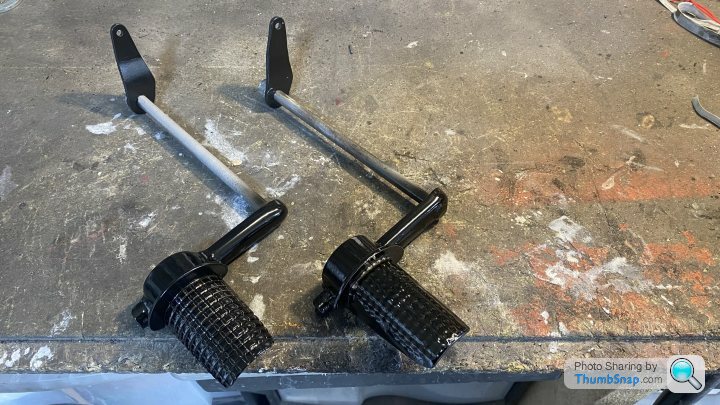
Frame stripped and ready for paint. All straight and in good condition - very nicely made actually. The steering head and seat brackets look like solid bronze (my metal recognition skills aren't great) and have been brazed on, but other brackets and bracing are welded on.
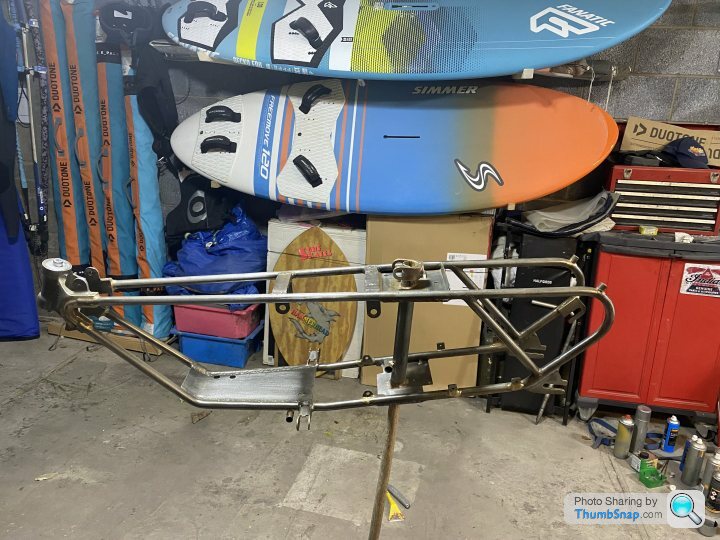
It isn't a big frame and I couldn't be bothered rigging up all the kosher spray stuff in the garage so it just got a rattle-can job. I didn't seem to have had an undercoat originally (assuming what was left before was original paint) and it was a real thin paint job so I replicated that. I wanted to avoid powder-coat as I think it looks wrong on older bikes - too think and shiny.
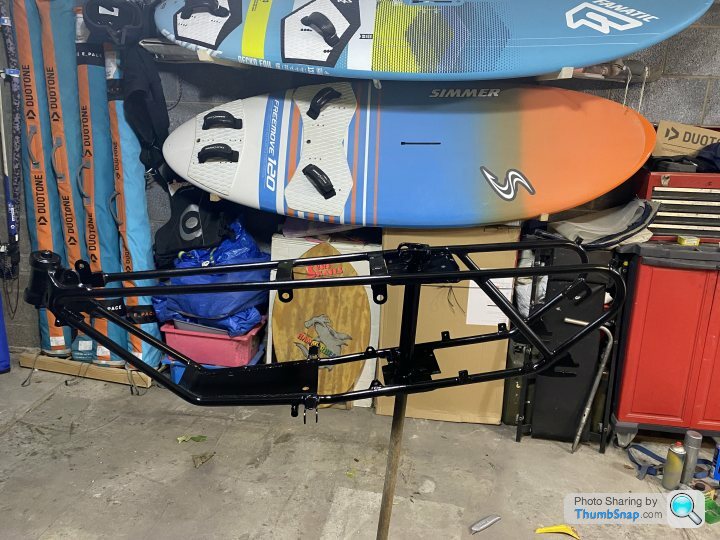
Everything else got paint too, but not too many photos. In order to get a decent paint job on the wheels without damaging it from fitting the tyres (which were little buggers to fit) I did the top coat after the tyres were fitted, glamping the tyres back from the rims.
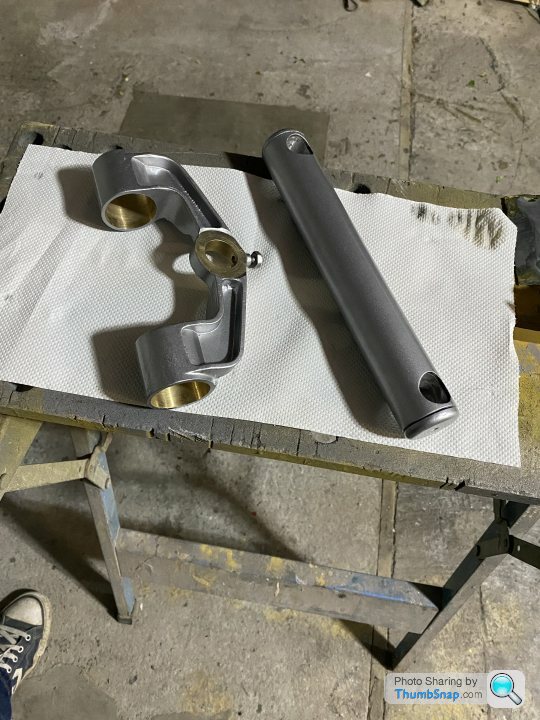
Engine out and ready to be looked at...
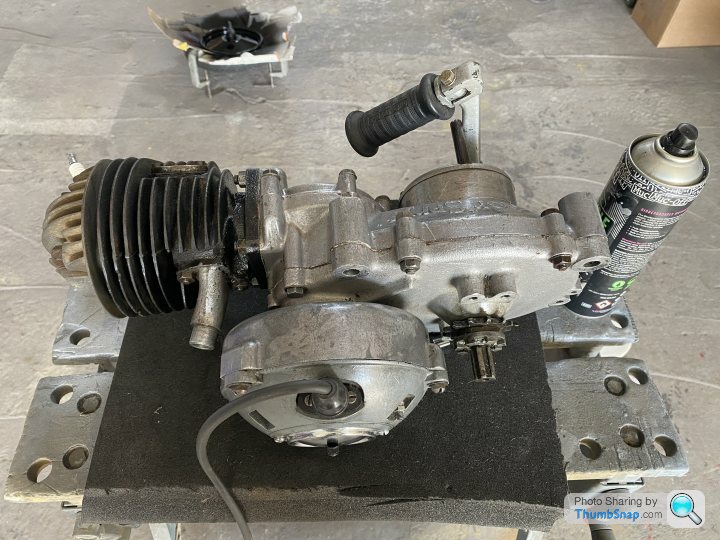
All seemed fine, so back together with a bit of polishing a repainting the barrel. ...and I couldn't resist polishing the originally [very] rough-cast exhaist manifold. My originality points have just gone out the window.
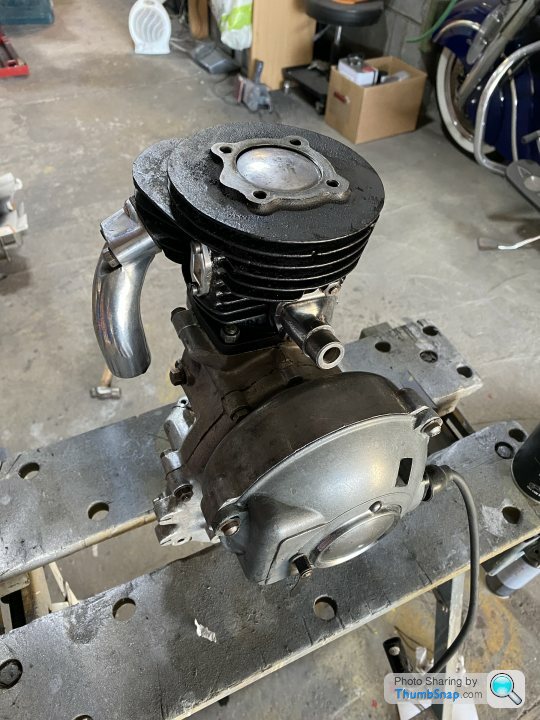
Starting to go back together.
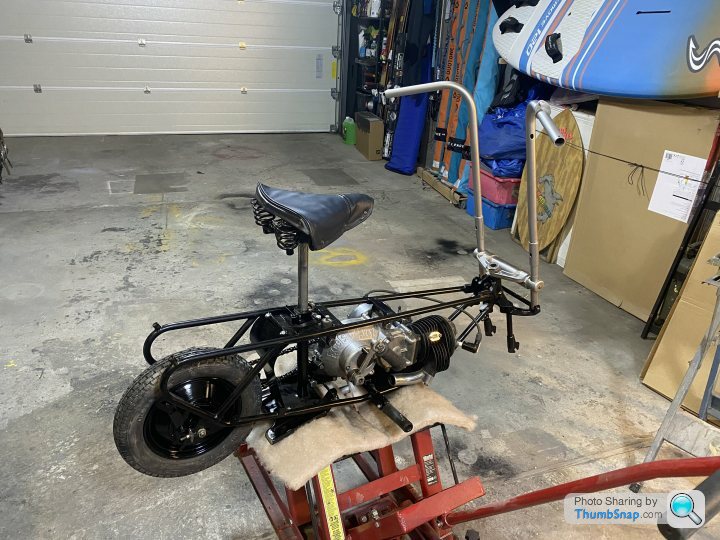
Rattle-can wasn't going to be good enough got tin-ware though, so rigged up a wee spray booth in the garage and used a 2-pack paint and 2-pack lacquer. Managed to get a pretty close match to the lowest layer of paint I came across, which I think was the original colour.
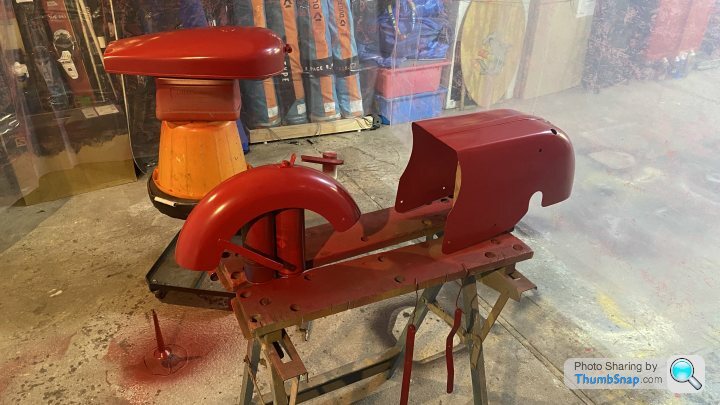
...and there we have it Lots of steps missed, but I finished it yesterday and after fixing a few fuel leaks (the cork washers/seal on the fuel tap had dried out), as had the washer on the carb union) I was zooming around town on it...much to the amusement of onlookers...if you can call a top speed of 30mph zooming.
Lots of steps missed, but I finished it yesterday and after fixing a few fuel leaks (the cork washers/seal on the fuel tap had dried out), as had the washer on the carb union) I was zooming around town on it...much to the amusement of onlookers...if you can call a top speed of 30mph zooming.
'Classic Transfers' still do the badges for these, so it's correctly badged-up too, The silencer end -piece collector thingy was also very rough cast and I just couldn't get the ingrained muck out, so I ended up polishing it too...I do like a bit of metal polishing
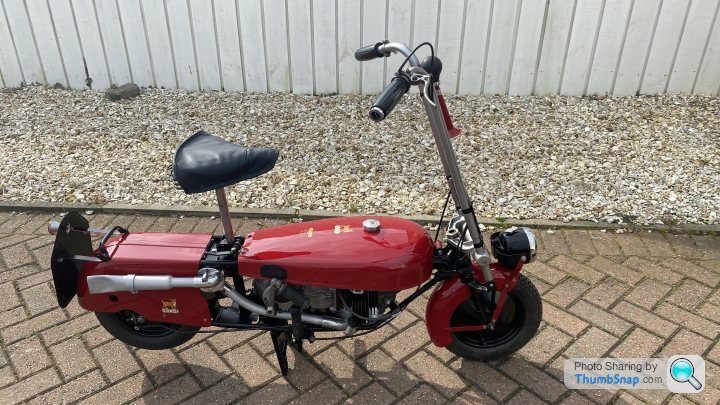
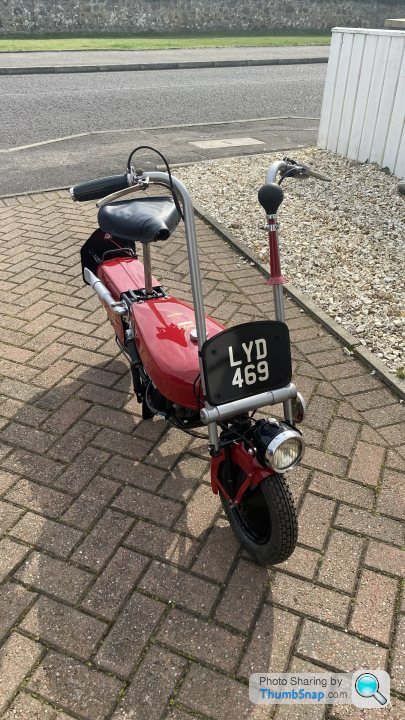
I got a replica tax disk made up for it's original date of registration (April 14, 1950) and the original location; it was first registered in Somerset.
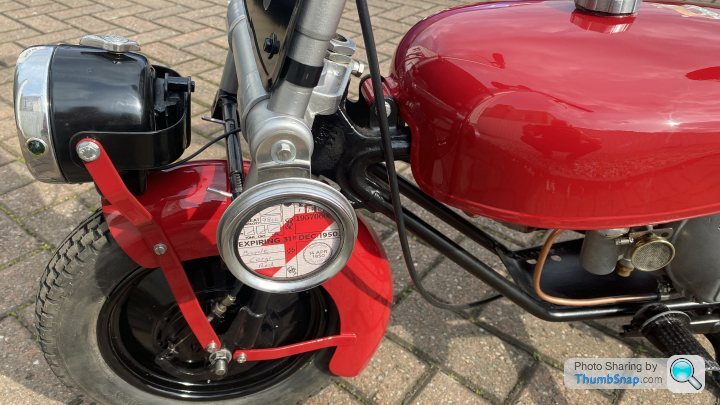
...and a few more pics...
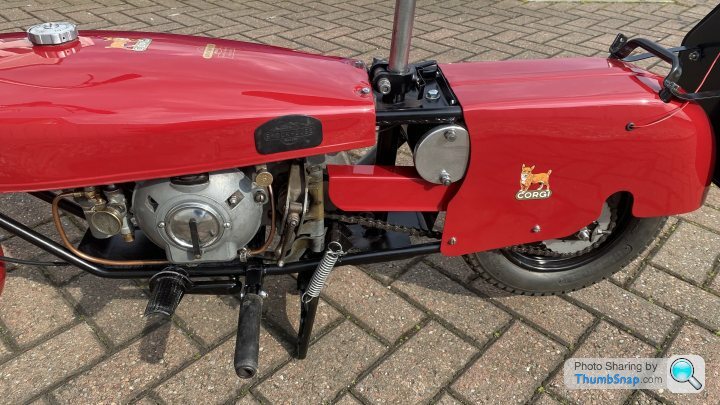
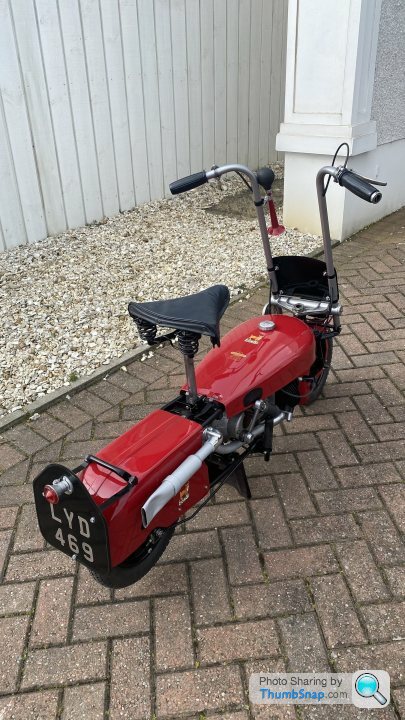
And it still folds
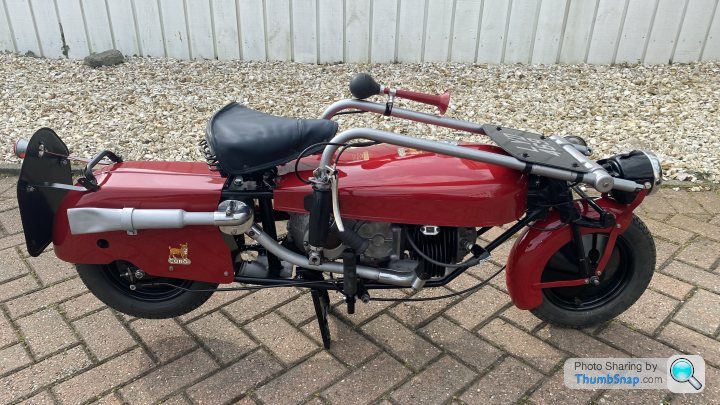
So, one down, another to go. Now the spring is here and it's riding (and windsurfing) season again I probably won't do much on Frankie until I'm forced to be garage-bound again in the autumn - so that's next winter's project. And it'll give me some time to look for some of the other elusive parts otherwise I'll just have to make them. But Lydia works - it runs - it starts, stops and steers...and it looks pretty good to my eyes too

I also managed to track down a headlamp, albeit rusty - I should have taken a proper 'before' picture. But it did have the original Lucas glass intact


But the rubber mount at the rear was perished and unserviceable.

So I cut it out, got some 2-part silicone rubber (and black die), made a wee mould and moulded-on a replacement. When ordering you have to state the hardness you want the finished product and I didn't have a clue...but whatever it is I chose seemed a pretty close match in flexibility to the rubber I expected. Funny stuff to work with though - unlike lots of other 2-part stuff where once the activator/hardner is added the whole lot cures, with this any part of the silicone liquid that hasn't been in direct contact/mix with the hardner doesn't cure so you have to mix it really well. You can see my new 'rubber' mount at the back, plus it cleaned-up pretty well ready for paint.

As standard the headlamp (and tail lamp, that I also got hold of and refurbed) are 6 volt off the generator, but the headlamp also should contain a couple of dry-cell batteries that you can switch between generator and batter power for the lights. But a) the battery terminals in the lamp had been eaten away, b) the 2-way switch was shagged and 3) 6v off a crappy generator isn't going to light much. So I put in a 12v rechargeable lithium battery pack (off a house alarm apparently) and reworked the lamps to take 12v LED bulbs and forgot about the generator. The lithium battery will power the lights for as long as I'd be riding it at a time. The finished lamp... I also had to tap-out quite a few dents in the rim and re-polish, but no 'before' pics



...and I had to make up the brackets etc., but no pics.
The tank didn't look too bad but it did have a few big dents in it. I did try to pull them out with a dent puller, but the metal was too thick to make much of a difference

So back to bare metal and filler. I tried to get down to what I thought was the original colour, and it was a bit brighter than the current top-coat. But once I did get down to bare metal (and no photos of this unfortunately) someone had been at the filler before me and it was really in a hell of a state with dents everywhere. No pics of work-in-progress, but it took over a week of a few hours a day filling and rubbing down (and tapping down the high spots) to get it looking like a tank again.

Frankie had no brake lever (amongst many other missing parts) so Lydia's is shown alone with my 'raw materials' - a bit of roll-cage tube a saved off the Tuscan (I keep all sorts of bits of scrap metal!), a rod, and my trusty sheet of mild steel. I bought this years ago as maybe 1/2 a square metre and I've used it for so many things!

So I cut parts out of the sheet steel, and turned grooves in a section of the tube. And I'd watched an Allen Millyard video of him putting horizontal grooves using the lathe making up hand grips to I copied that.

The brake lever arm was probably made originally with a die on a press, but mine was made beating hell out of my sheet steel part with a lump hammer, and then welding up the 'seam' at the curved end.

Then all welded-up and painted - my 'fake' lever is on the left, the original from Lydia is on the right. OK, not absolutely identical, I think they must have cast-on the 'treads' on the original, but close enough - a blind-man would be pleased to see it.

Frame stripped and ready for paint. All straight and in good condition - very nicely made actually. The steering head and seat brackets look like solid bronze (my metal recognition skills aren't great) and have been brazed on, but other brackets and bracing are welded on.

It isn't a big frame and I couldn't be bothered rigging up all the kosher spray stuff in the garage so it just got a rattle-can job. I didn't seem to have had an undercoat originally (assuming what was left before was original paint) and it was a real thin paint job so I replicated that. I wanted to avoid powder-coat as I think it looks wrong on older bikes - too think and shiny.

Everything else got paint too, but not too many photos. In order to get a decent paint job on the wheels without damaging it from fitting the tyres (which were little buggers to fit) I did the top coat after the tyres were fitted, glamping the tyres back from the rims.

Engine out and ready to be looked at...

All seemed fine, so back together with a bit of polishing a repainting the barrel. ...and I couldn't resist polishing the originally [very] rough-cast exhaist manifold. My originality points have just gone out the window.

Starting to go back together.

Rattle-can wasn't going to be good enough got tin-ware though, so rigged up a wee spray booth in the garage and used a 2-pack paint and 2-pack lacquer. Managed to get a pretty close match to the lowest layer of paint I came across, which I think was the original colour.

...and there we have it
 Lots of steps missed, but I finished it yesterday and after fixing a few fuel leaks (the cork washers/seal on the fuel tap had dried out), as had the washer on the carb union) I was zooming around town on it...much to the amusement of onlookers...if you can call a top speed of 30mph zooming.
Lots of steps missed, but I finished it yesterday and after fixing a few fuel leaks (the cork washers/seal on the fuel tap had dried out), as had the washer on the carb union) I was zooming around town on it...much to the amusement of onlookers...if you can call a top speed of 30mph zooming.'Classic Transfers' still do the badges for these, so it's correctly badged-up too, The silencer end -piece collector thingy was also very rough cast and I just couldn't get the ingrained muck out, so I ended up polishing it too...I do like a bit of metal polishing



I got a replica tax disk made up for it's original date of registration (April 14, 1950) and the original location; it was first registered in Somerset.

...and a few more pics...


And it still folds


So, one down, another to go. Now the spring is here and it's riding (and windsurfing) season again I probably won't do much on Frankie until I'm forced to be garage-bound again in the autumn - so that's next winter's project. And it'll give me some time to look for some of the other elusive parts otherwise I'll just have to make them. But Lydia works - it runs - it starts, stops and steers...and it looks pretty good to my eyes too

Janluke said:
Looks great, looking forward to seeing it in the flesh.
Was your Hurricane at a classic show in Peebles yesterday?
No - I was on holiday when the entry forms went out and only saw them last week when I got back. I emailed to say I could take the Hurricane or the Chief down, but by that time all the places were filled. Meant I could work in the garage Was your Hurricane at a classic show in Peebles yesterday?
 I had plotted going down for the auto-jumble but the opportunity to get the Corgi out and about in the sum proved too strong.
I had plotted going down for the auto-jumble but the opportunity to get the Corgi out and about in the sum proved too strong. I'd planned to leave the s tty one, Frankie, as a project for next winter...but it kind if annoyed me every time I passed it in the garage sitting there in a sad state. So I started on the forks/headstock, that REALLY annoyed me.
tty one, Frankie, as a project for next winter...but it kind if annoyed me every time I passed it in the garage sitting there in a sad state. So I started on the forks/headstock, that REALLY annoyed me.
Remembering this famous bodge, no nuts on the headstock - they're put on a big washer, drilled a hole in the stem and put a split-pin through. Not surprisingly the forks rattled about, and below that was a rusted-out ballrace that had been further gummed-up with paint.

First task was to get the stem roughly round again and a tiny bit oversized at the top where the threads were really mashed,.
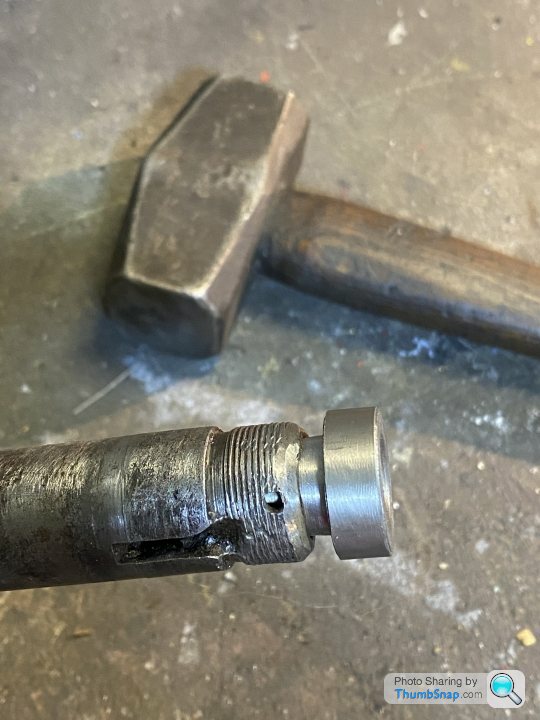
so I made up a small 'cone' and beat the hell out of it down the headstock tube and ended up with something approximating to round,
Next it was hours with a thread file recovering/remaking threads...
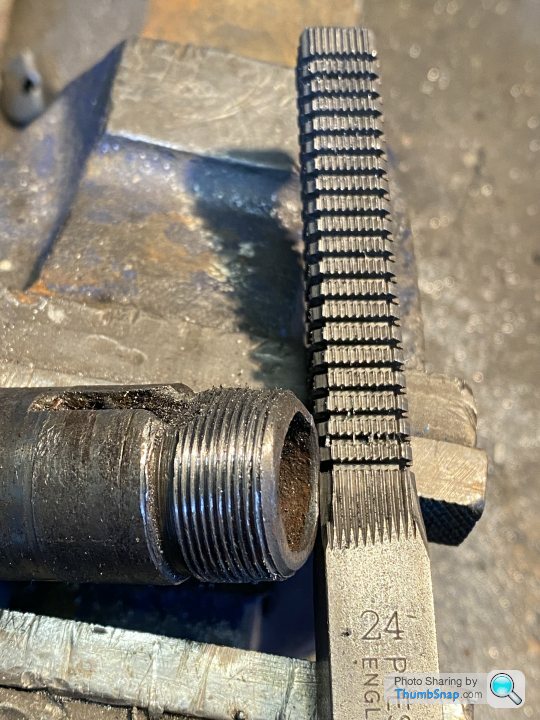
Now we have the challenge of the nuts. Typing this I can't recall the size, but they're quite big and 24tpi. I looked everywhere on- and off-line and eventually came up with just one. A mate was down at the Stafford show and he went with my one nut (ooh er missus) looking for another but came back empty handed. Only one thing for it - my lathe (circa 1948) does have thread cutting capabilities but I'd never tried it before. But I did have enough of the gears to set it up for 24tpi.
So we start with a block of steel and the existing nut as a template...and a hacksaw. The washers are just to stop the metal getting damaged by the mole grips, I used a pair so I could clamp it at different sides as I moved to cut each side. In retrospect I should have just drilled a home through the middle and clamped them together with a nut and bolt. I'll know for the next time
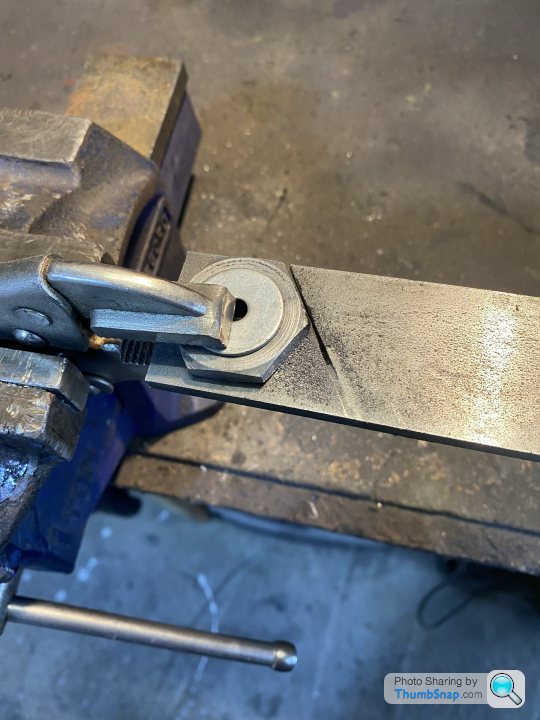
And now we have the outline of a nut, with a bit of filing on the edges to tidy things up..
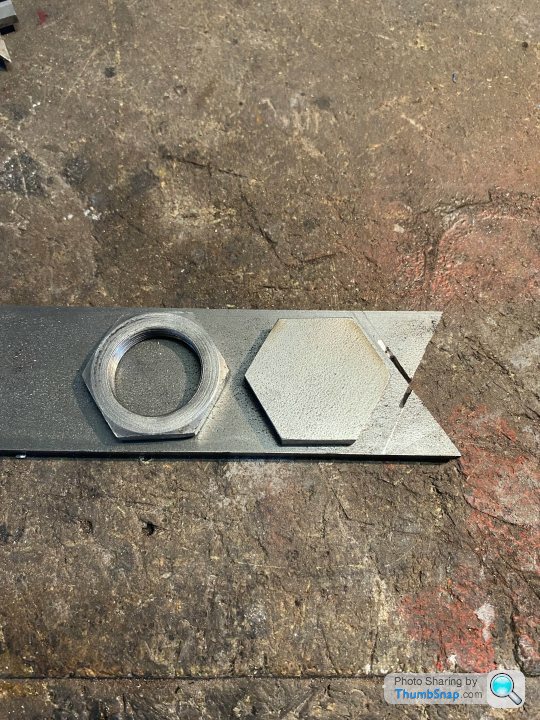
And after a little time on the lathe, and a bit of metal polishing (I can't resist metal polishing) we have my nut on the left and standard on the right
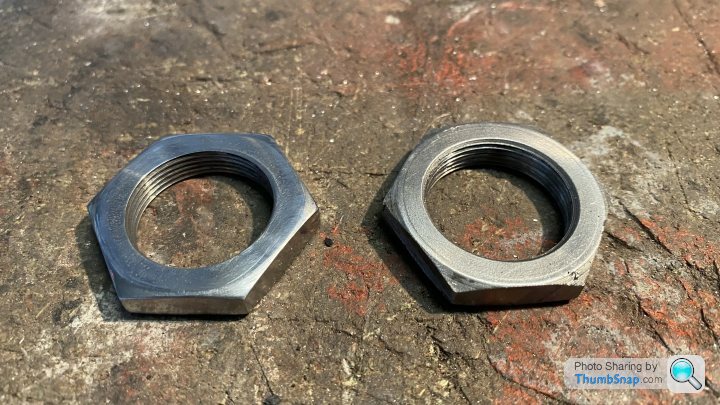
All that for a bloody nut eh? Anyway, it was quite fulfilling.
Thoughts now moved to the ball races. The bottom one was actually OK, and the top one in the frame was fine too - but the one of the forks was just a ring of rust. After much time with a wire brush I eventually got to solid metal, but this isn't exactly a smooth surface.
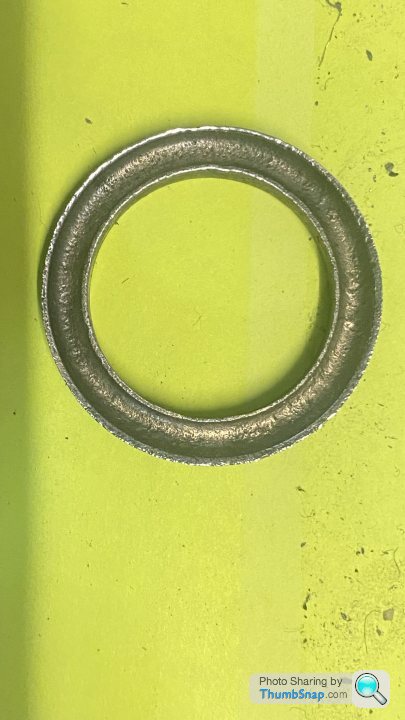
Obviously I've got a lathe, but I'm no expert and still working out how to do things and I couldn't work out how to hold the race in the lathe - no use trying to just grip it in the chuck. So I worked out I could machine up a 'holder' for the race where it's a [very] tight press-fit against a square edge. I then made up a 'tool' approximating to the diameter I wanted in the race and off we went.
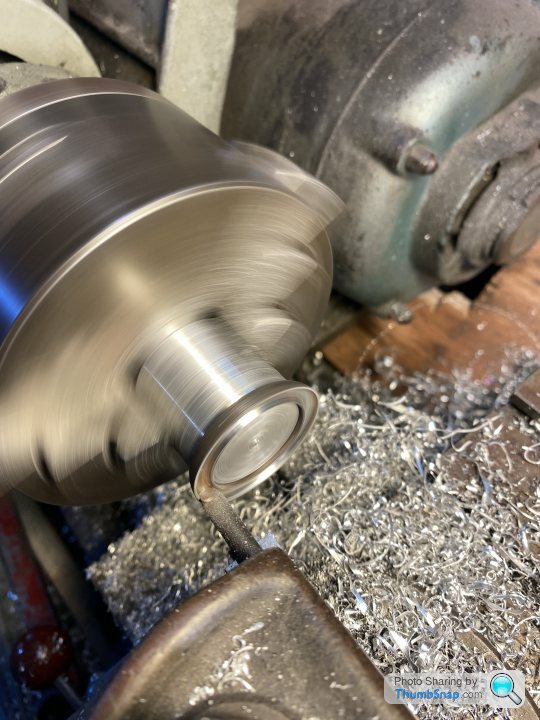
OK, I'm no Allen Millyard but I'm getting through this thing. But don't plan to do much more on this one till the winter.
But since Lydia let me down at the weekend with no spark when hot I'll be changing the ignition coil and condenser on that. I knew the lighting coils were knackered and so wired it to run LED bulbs off a wee 12v battery. And since I'll be changing the ignition coil I also managed to get 2 lighting coils (same as a Bantam) so I might swap back to 6v LEDs and junk the battery.
 tty one, Frankie, as a project for next winter...but it kind if annoyed me every time I passed it in the garage sitting there in a sad state. So I started on the forks/headstock, that REALLY annoyed me.
tty one, Frankie, as a project for next winter...but it kind if annoyed me every time I passed it in the garage sitting there in a sad state. So I started on the forks/headstock, that REALLY annoyed me.Remembering this famous bodge, no nuts on the headstock - they're put on a big washer, drilled a hole in the stem and put a split-pin through. Not surprisingly the forks rattled about, and below that was a rusted-out ballrace that had been further gummed-up with paint.

First task was to get the stem roughly round again and a tiny bit oversized at the top where the threads were really mashed,.

so I made up a small 'cone' and beat the hell out of it down the headstock tube and ended up with something approximating to round,
Next it was hours with a thread file recovering/remaking threads...

Now we have the challenge of the nuts. Typing this I can't recall the size, but they're quite big and 24tpi. I looked everywhere on- and off-line and eventually came up with just one. A mate was down at the Stafford show and he went with my one nut (ooh er missus) looking for another but came back empty handed. Only one thing for it - my lathe (circa 1948) does have thread cutting capabilities but I'd never tried it before. But I did have enough of the gears to set it up for 24tpi.
So we start with a block of steel and the existing nut as a template...and a hacksaw. The washers are just to stop the metal getting damaged by the mole grips, I used a pair so I could clamp it at different sides as I moved to cut each side. In retrospect I should have just drilled a home through the middle and clamped them together with a nut and bolt. I'll know for the next time


And now we have the outline of a nut, with a bit of filing on the edges to tidy things up..

And after a little time on the lathe, and a bit of metal polishing (I can't resist metal polishing) we have my nut on the left and standard on the right


All that for a bloody nut eh? Anyway, it was quite fulfilling.
Thoughts now moved to the ball races. The bottom one was actually OK, and the top one in the frame was fine too - but the one of the forks was just a ring of rust. After much time with a wire brush I eventually got to solid metal, but this isn't exactly a smooth surface.

Obviously I've got a lathe, but I'm no expert and still working out how to do things and I couldn't work out how to hold the race in the lathe - no use trying to just grip it in the chuck. So I worked out I could machine up a 'holder' for the race where it's a [very] tight press-fit against a square edge. I then made up a 'tool' approximating to the diameter I wanted in the race and off we went.

OK, I'm no Allen Millyard but I'm getting through this thing. But don't plan to do much more on this one till the winter.
But since Lydia let me down at the weekend with no spark when hot I'll be changing the ignition coil and condenser on that. I knew the lighting coils were knackered and so wired it to run LED bulbs off a wee 12v battery. And since I'll be changing the ignition coil I also managed to get 2 lighting coils (same as a Bantam) so I might swap back to 6v LEDs and junk the battery.
Time for another update I guess. Maybe not as exciting as some of the other restoration tales, but it’s starting to keep me busy again. If you’re interested in the continuing saga of Frankie, sit down with a large coffee (or booze, it’s Xmas/New Year after all) and read on.
I didn’t do any work on the Corgis over the summer, but I did potter about a few times on Lydia, now it’s complete. I did a VMCC Tiddler run on it (and not everyone that turned up was on a tiddler). I think the route was around 40 miles, but in the afternoon on a particularly long uphill stretch it slowed and eventually stopped. No spark diagnosed, so recovered by the van of shame The good news it was easy to lift in and out – and once it cooled right down there was a feeble spark back again. So I put in a new coil in the magneto, and while I was at it 2 new lighting coils as well. They’d never worked, but the Lucas ‘headlamp’ switches between internal battery or generator, and I’d just run it off a (rechargeable) battery. But now I have lights off the generator. But I’d put in LED bulbs and with no regulator or rectifier the bulbs flash based on engine speed – maybe no bad thing as they’re really for visibility – they sure as hell ain’t going to light the road up!
The good news it was easy to lift in and out – and once it cooled right down there was a feeble spark back again. So I put in a new coil in the magneto, and while I was at it 2 new lighting coils as well. They’d never worked, but the Lucas ‘headlamp’ switches between internal battery or generator, and I’d just run it off a (rechargeable) battery. But now I have lights off the generator. But I’d put in LED bulbs and with no regulator or rectifier the bulbs flash based on engine speed – maybe no bad thing as they’re really for visibility – they sure as hell ain’t going to light the road up!

So with the nights starting to draw in, it was back into the garage. First task was to put electronic ignition on the ’47 Indian Chief (still retains its manual advance/retard), but I digress…

Starting the disassembly I got the bike on the lift – just lifted it on, rather than having to pump it up!

With everything off and the paint stripped from the frame, and surprisingly no horrors found (for once!) I wanted to see if I could get the motor running before going any further. Easiest way to hold the motor down to try to get it going is in the frame…but the bottom engine brackets were missing. New ones duly fitted.
It originally had the wrong carb on it, some Villiers thing with the float bowl on the right so some clown had fitted it way out the side on the long tube. Luckily they hadn’t messed with the manifold. I managed to get the correct carb (at least the body) off eBay, from an outboard motor I gather. And with new jets and needle and other bits it should be ready to go. And I couldn’t resist polishing it!

No spark, maybe not surprisingly, and inside the mag it just smelt of buring and damp. New ignition coil duly fitted, and while I was at it put in new lighting coils too as they looked and smelled buggered, and someone had been messing with them before me. New stuff now fitted, and junk removed on the left.
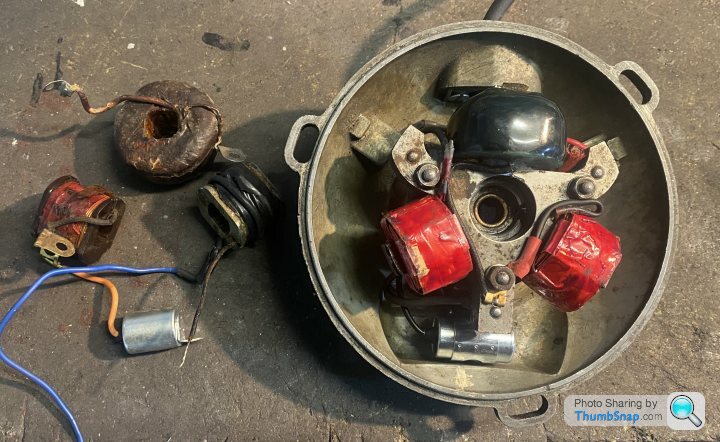
There’s no kick start on a Mk1 Corgi, so it’s push-to-go. But with the help of a cordless drill (in reverse) and a socket on the engine sprocket and jerry-rigged fuel and throttle it fired up!

The back wheel annoyed me, or at least the ham-fistedness of whatever monkey had this in the past. Rather than fit an inner tube with a 90 degree valve, they fitted a regular tube and then cut/chopped/bashed hell out of the wheel to get an airline in. Cretins.

OK, maybe not the best welding (and it was bloody difficult at my skill level as the wheel was so thin in places is kept burning through), but solid again. And not helped by the fact they'd welded the damned sprocket on! But with a wee bit of body filler and it will look fine again.

Attention now comes to the forks. On this bike they’re sprung, but everything totally jammed up with paint (and corrosion). And the mechanism to fold the bars down and in was also totally jammed.


What a bugger to get them apart – loads of heat and a lump hammer, not helped by the cross tube that lets the forks fold having a bloody great bash in it so difficult to get out the mounts. It needed to be round again so it’s a sliding fit, so solution was to get a hardened steel bearing of exactly the right inner diameter of the tube, and bash the hell out of it down the tube a few times.


I then ran it down the lathe to take some of the high spots off, but some of the tube wall remains a bit marked, but it does now fit properly again.
Then there’s meant to be a long bolt affair to lock the bars – the bike with the solid forks has a far better arrangement with sprung clips, but the bars on that do wobble a bit, and so maybe they swapped to the bolt to make it more solid. Anyway, I had nothing to go on other than a picture from the parts list (and obviously parts haven’t been available for 70-odd years). So I’m missing parts 15, 16 and 17 in this instance.

I had a big steel rod in my bin of ‘useful bits of metal’ that I turned down and threaded. I don’t have a centre support thingy for the lathe so with the length of the rod as it got thinner it wobbled a bit, so not the best bit if turning…but it will do. Then a spacer and the basis of the ‘nut’ thingy. I also made up the thumbscrew/handle thing – I think the ball on the end should probably be round, but I don’t have the ball-making tool holder for the lathe so just did it by eye. I’d planned just to thread the thumbscrew and the ‘nut’, but I couldn’t get enough depth of threads to get a really solid purchase to I ended up welding it.


so my 'reproduction' is kind of like the picture.
…and here’s the forks, less paint, but all working/folding with my new thumbscrew clamp thingy etc.

Next I need to weld on a footrest bracket to the frame, that inexplicably someone’s chopped of – I’ve made the bracket already. And then with a bit of further clean-up the frame and forks will be ready for paint. But I think I also might strip down the wee motor first, as having managed to get it fired-up it’s now dribbling oil. Anyway…onwards and upwards.
I didn’t do any work on the Corgis over the summer, but I did potter about a few times on Lydia, now it’s complete. I did a VMCC Tiddler run on it (and not everyone that turned up was on a tiddler). I think the route was around 40 miles, but in the afternoon on a particularly long uphill stretch it slowed and eventually stopped. No spark diagnosed, so recovered by the van of shame
 The good news it was easy to lift in and out – and once it cooled right down there was a feeble spark back again. So I put in a new coil in the magneto, and while I was at it 2 new lighting coils as well. They’d never worked, but the Lucas ‘headlamp’ switches between internal battery or generator, and I’d just run it off a (rechargeable) battery. But now I have lights off the generator. But I’d put in LED bulbs and with no regulator or rectifier the bulbs flash based on engine speed – maybe no bad thing as they’re really for visibility – they sure as hell ain’t going to light the road up!
The good news it was easy to lift in and out – and once it cooled right down there was a feeble spark back again. So I put in a new coil in the magneto, and while I was at it 2 new lighting coils as well. They’d never worked, but the Lucas ‘headlamp’ switches between internal battery or generator, and I’d just run it off a (rechargeable) battery. But now I have lights off the generator. But I’d put in LED bulbs and with no regulator or rectifier the bulbs flash based on engine speed – maybe no bad thing as they’re really for visibility – they sure as hell ain’t going to light the road up!
So with the nights starting to draw in, it was back into the garage. First task was to put electronic ignition on the ’47 Indian Chief (still retains its manual advance/retard), but I digress…

Starting the disassembly I got the bike on the lift – just lifted it on, rather than having to pump it up!

With everything off and the paint stripped from the frame, and surprisingly no horrors found (for once!) I wanted to see if I could get the motor running before going any further. Easiest way to hold the motor down to try to get it going is in the frame…but the bottom engine brackets were missing. New ones duly fitted.
It originally had the wrong carb on it, some Villiers thing with the float bowl on the right so some clown had fitted it way out the side on the long tube. Luckily they hadn’t messed with the manifold. I managed to get the correct carb (at least the body) off eBay, from an outboard motor I gather. And with new jets and needle and other bits it should be ready to go. And I couldn’t resist polishing it!

No spark, maybe not surprisingly, and inside the mag it just smelt of buring and damp. New ignition coil duly fitted, and while I was at it put in new lighting coils too as they looked and smelled buggered, and someone had been messing with them before me. New stuff now fitted, and junk removed on the left.

There’s no kick start on a Mk1 Corgi, so it’s push-to-go. But with the help of a cordless drill (in reverse) and a socket on the engine sprocket and jerry-rigged fuel and throttle it fired up!


The back wheel annoyed me, or at least the ham-fistedness of whatever monkey had this in the past. Rather than fit an inner tube with a 90 degree valve, they fitted a regular tube and then cut/chopped/bashed hell out of the wheel to get an airline in. Cretins.

OK, maybe not the best welding (and it was bloody difficult at my skill level as the wheel was so thin in places is kept burning through), but solid again. And not helped by the fact they'd welded the damned sprocket on! But with a wee bit of body filler and it will look fine again.

Attention now comes to the forks. On this bike they’re sprung, but everything totally jammed up with paint (and corrosion). And the mechanism to fold the bars down and in was also totally jammed.


What a bugger to get them apart – loads of heat and a lump hammer, not helped by the cross tube that lets the forks fold having a bloody great bash in it so difficult to get out the mounts. It needed to be round again so it’s a sliding fit, so solution was to get a hardened steel bearing of exactly the right inner diameter of the tube, and bash the hell out of it down the tube a few times.


I then ran it down the lathe to take some of the high spots off, but some of the tube wall remains a bit marked, but it does now fit properly again.
Then there’s meant to be a long bolt affair to lock the bars – the bike with the solid forks has a far better arrangement with sprung clips, but the bars on that do wobble a bit, and so maybe they swapped to the bolt to make it more solid. Anyway, I had nothing to go on other than a picture from the parts list (and obviously parts haven’t been available for 70-odd years). So I’m missing parts 15, 16 and 17 in this instance.

I had a big steel rod in my bin of ‘useful bits of metal’ that I turned down and threaded. I don’t have a centre support thingy for the lathe so with the length of the rod as it got thinner it wobbled a bit, so not the best bit if turning…but it will do. Then a spacer and the basis of the ‘nut’ thingy. I also made up the thumbscrew/handle thing – I think the ball on the end should probably be round, but I don’t have the ball-making tool holder for the lathe so just did it by eye. I’d planned just to thread the thumbscrew and the ‘nut’, but I couldn’t get enough depth of threads to get a really solid purchase to I ended up welding it.


so my 'reproduction' is kind of like the picture.
…and here’s the forks, less paint, but all working/folding with my new thumbscrew clamp thingy etc.

Next I need to weld on a footrest bracket to the frame, that inexplicably someone’s chopped of – I’ve made the bracket already. And then with a bit of further clean-up the frame and forks will be ready for paint. But I think I also might strip down the wee motor first, as having managed to get it fired-up it’s now dribbling oil. Anyway…onwards and upwards.
Edited by tvrolet on Friday 30th December 17:05
Dunno how many folks are interested in this, but I started documenting the rebuilds so I’ll continue.
I’ll start with the saga of the mullered wheels. As in a previous episode the rear wheel had been badly butchered; but the front hadn’t escaped whoever the gorilla was either. At least this didn’t have bits chopped out, just bashed-in; this is after I managed to get the worst of the dents out with a DIY dent-basher-outer that went in through the air valve hole.
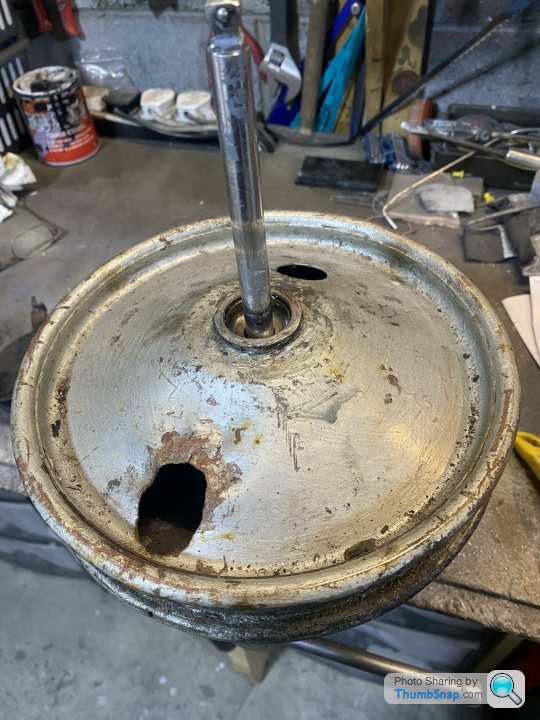
I also replaced the standard old and worn cup and cone bearings with modern sealed bearings, making a spacer to allow them to be bolted-up on the axles. Ready to roll…

I fancied a change from spannering and making stuff, so turned my attention to the rear mudguard. It wasn’t in great shape with a big bash in one side (that 'crease' shouldn't be there), a wee bit chopped out and loads of holes where holes shouldn’t be...and rust.

This was the first time I started getting the paint off the tinware, and while my paint removal was quite gentle, the a gorilla before me had obviously used a coarse sanding disk on a previous re-paint, so it had loads of really deep scores. Anyway, chopped-out bit replaced and holes that shouldn't be there welded up. My panel beating and welding skills on 75-year-old thin metal are getting better!

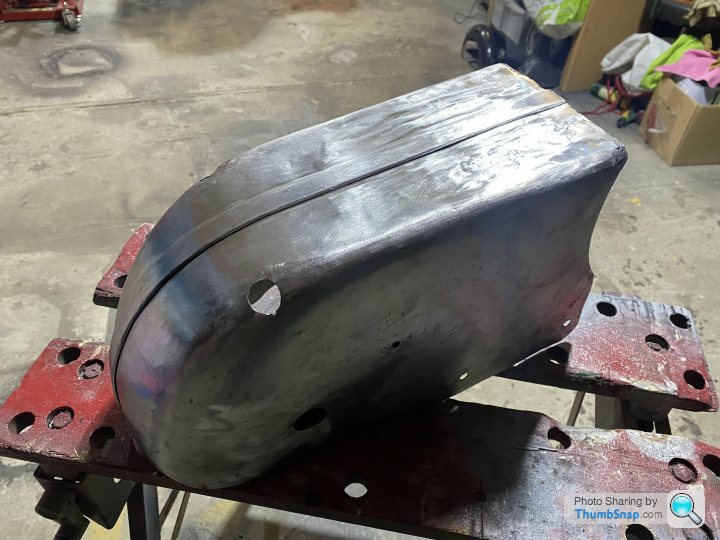 [url]
[url]
Primed and ready to go (lots of coats and wet and dry!). These are the holes it’s meant to have.

I got a rod for the rear brake and got a die to put on the proper ¼” x 26tpi threads…assuming a clevis with a 3/8” pin and these threads would be easy to get. They weren’t – doh – I should have put threads on to match the clevis that were available. Anyway, the clevis used on Corgis are unusually long, so I decided to just make them. Started with a square bar, and a bolt to make up the actual pins.
– I should have put threads on to match the clevis that were available. Anyway, the clevis used on Corgis are unusually long, so I decided to just make them. Started with a square bar, and a bolt to make up the actual pins.
 [url]
[url]
Work in progress before I cut the slots and tapped/threaded the holes. I ordered a cutter of the right size (3/8") from eBay, and unbeknownst to me it came from China and took ages to arrive. Then the cutting edges snapped in minutes and much cursing ensued . Eventually got them slotted but not such a neat job - note to self, always check country of origin and don't buy Chinese tools.
. Eventually got them slotted but not such a neat job - note to self, always check country of origin and don't buy Chinese tools.
 [url]
[url]
And slotted and on the brake rod ready to go.

Someone had chopped the left hand footrest bracket off the frame and instead put a bar through the brake pedal pivot (losing the rear brake pedal and mechanism in the process!). To make up a matching footrest to the right one I had I used a bit of bar, a washer and a length of hose. As standard they’d flared out the end of the tube to be a tight fit on the washer…which I managed to replicate on the lathe with the help of a tyre lever.

New footrest bracket made and welded to frame, and new footrest made – a decent match to the original on the right side.
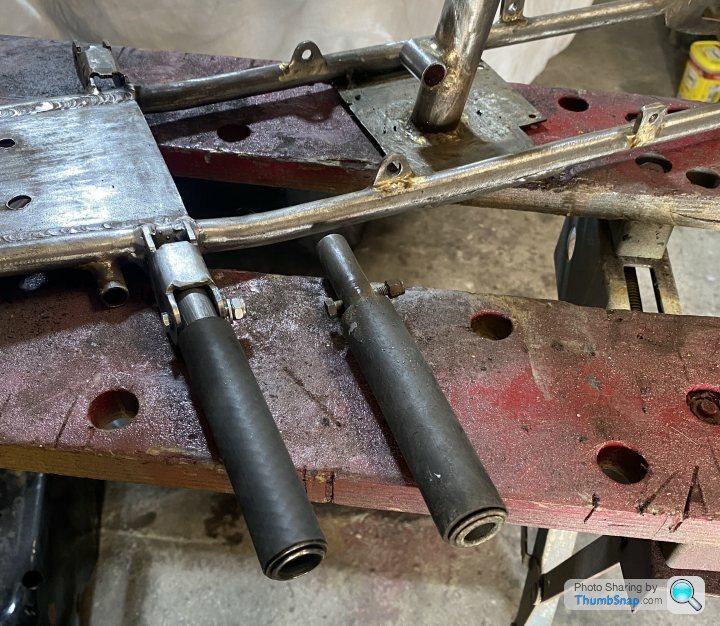
Don’t really have an in-progress or ‘after’, but I refurbed the brakes so here's a 'before' pic of the front brake backing plate. Pretty solid under the grime/surface rust, but the bracket that holds the brake cable had been snapped off previously and brazed back on - it just came way again in my hands to I had to re-make and weld-on a replacement.

Started work on the frame – the same gorilla with the coarse sanding disk had got there before me at some point on the past too. The tubes were all solid and straight, but like extruded thruppenny bits with loads of flats . This is half way through the filler primer/sanding stage to make them look round again for paint.
. This is half way through the filler primer/sanding stage to make them look round again for paint.

Got that all done and painted frame – just a rattle-can job as it's too much hassle to set the spray gun up and cover absolutely everything in the garage from paint dust. I'll do a proper job on the tank and tinware, but cans are fine for the frame. And the tubes all look round!

Engine next, and I got carried away with the work and forgot to take pics. But I knew it ran as I'd built a new carb for it and put on a new ignition coil and points before I took it out the chassis - keep up at the back Spare parts spare pretty much non-existent, which is why I had to make up so much from scratch, but I did manage to get hold of a (much used) replacement barrel. The original had fins missing and the base flange was broken too so it would have been a fair bit of cast-iron welding which is beyond my skill set. Cleaned up and ready for a bit of paint.
Spare parts spare pretty much non-existent, which is why I had to make up so much from scratch, but I did manage to get hold of a (much used) replacement barrel. The original had fins missing and the base flange was broken too so it would have been a fair bit of cast-iron welding which is beyond my skill set. Cleaned up and ready for a bit of paint.

Clutch was down to the rivets, so got that recorked…mmmmm, cork.

Going back together with new DIY gaskets. Forgot to take any pics with the cases split and a pile of parts
 [url]
[url]
Looking good…
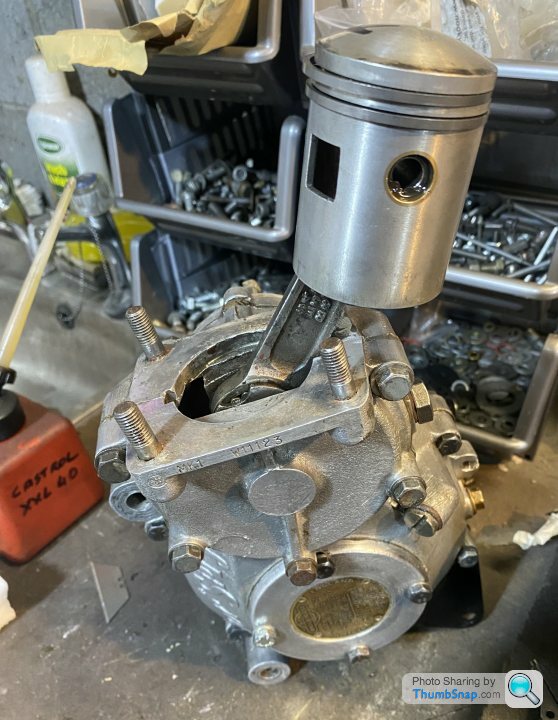 |https://thumbsnap.com/XgTDSoGU[/url]
|https://thumbsnap.com/XgTDSoGU[/url]
…and a big step forward over the past week with motor all back together, refurbed wheels on, refurbed forks and head races back on, and my home-made head nuts. I’d managed to pick-up a used silencer body with an intact right hand casting…which would have been a bugger to make otherwise, so I polished it within an inch of its life - the purists would weep. Left end was broken but it’s just a simple disk made up on the lathe. The rear brake pedal, rod & clevis I’d made earlier fitted and on; likewise the stand and stand toggle affair. New engine mounts and various other refurbed and re-made bits and pieces, but starting to look like a (small) bike!
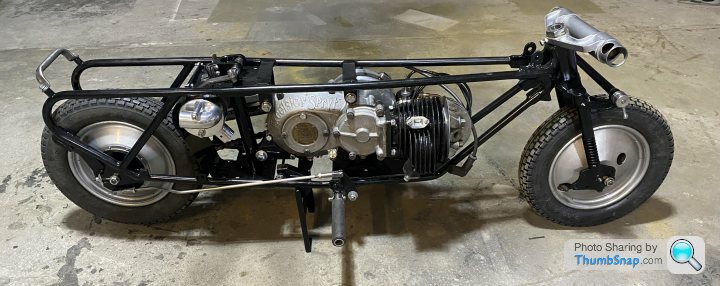
I cant help thinking that with a set of clip-ons and rear-sets this would make a great café-racer for a short person.
I’ll start with the saga of the mullered wheels. As in a previous episode the rear wheel had been badly butchered; but the front hadn’t escaped whoever the gorilla was either. At least this didn’t have bits chopped out, just bashed-in; this is after I managed to get the worst of the dents out with a DIY dent-basher-outer that went in through the air valve hole.

I also replaced the standard old and worn cup and cone bearings with modern sealed bearings, making a spacer to allow them to be bolted-up on the axles. Ready to roll…

I fancied a change from spannering and making stuff, so turned my attention to the rear mudguard. It wasn’t in great shape with a big bash in one side (that 'crease' shouldn't be there), a wee bit chopped out and loads of holes where holes shouldn’t be...and rust.

This was the first time I started getting the paint off the tinware, and while my paint removal was quite gentle, the a gorilla before me had obviously used a coarse sanding disk on a previous re-paint, so it had loads of really deep scores. Anyway, chopped-out bit replaced and holes that shouldn't be there welded up. My panel beating and welding skills on 75-year-old thin metal are getting better!

 [url]
[url]Primed and ready to go (lots of coats and wet and dry!). These are the holes it’s meant to have.

I got a rod for the rear brake and got a die to put on the proper ¼” x 26tpi threads…assuming a clevis with a 3/8” pin and these threads would be easy to get. They weren’t – doh
 – I should have put threads on to match the clevis that were available. Anyway, the clevis used on Corgis are unusually long, so I decided to just make them. Started with a square bar, and a bolt to make up the actual pins.
– I should have put threads on to match the clevis that were available. Anyway, the clevis used on Corgis are unusually long, so I decided to just make them. Started with a square bar, and a bolt to make up the actual pins. [url]
[url]Work in progress before I cut the slots and tapped/threaded the holes. I ordered a cutter of the right size (3/8") from eBay, and unbeknownst to me it came from China and took ages to arrive. Then the cutting edges snapped in minutes and much cursing ensued
 . Eventually got them slotted but not such a neat job - note to self, always check country of origin and don't buy Chinese tools.
. Eventually got them slotted but not such a neat job - note to self, always check country of origin and don't buy Chinese tools. [url]
[url]And slotted and on the brake rod ready to go.

Someone had chopped the left hand footrest bracket off the frame and instead put a bar through the brake pedal pivot (losing the rear brake pedal and mechanism in the process!). To make up a matching footrest to the right one I had I used a bit of bar, a washer and a length of hose. As standard they’d flared out the end of the tube to be a tight fit on the washer…which I managed to replicate on the lathe with the help of a tyre lever.

New footrest bracket made and welded to frame, and new footrest made – a decent match to the original on the right side.

Don’t really have an in-progress or ‘after’, but I refurbed the brakes so here's a 'before' pic of the front brake backing plate. Pretty solid under the grime/surface rust, but the bracket that holds the brake cable had been snapped off previously and brazed back on - it just came way again in my hands to I had to re-make and weld-on a replacement.

Started work on the frame – the same gorilla with the coarse sanding disk had got there before me at some point on the past too. The tubes were all solid and straight, but like extruded thruppenny bits with loads of flats
 . This is half way through the filler primer/sanding stage to make them look round again for paint.
. This is half way through the filler primer/sanding stage to make them look round again for paint.
Got that all done and painted frame – just a rattle-can job as it's too much hassle to set the spray gun up and cover absolutely everything in the garage from paint dust. I'll do a proper job on the tank and tinware, but cans are fine for the frame. And the tubes all look round!


Engine next, and I got carried away with the work and forgot to take pics. But I knew it ran as I'd built a new carb for it and put on a new ignition coil and points before I took it out the chassis - keep up at the back
 Spare parts spare pretty much non-existent, which is why I had to make up so much from scratch, but I did manage to get hold of a (much used) replacement barrel. The original had fins missing and the base flange was broken too so it would have been a fair bit of cast-iron welding which is beyond my skill set. Cleaned up and ready for a bit of paint.
Spare parts spare pretty much non-existent, which is why I had to make up so much from scratch, but I did manage to get hold of a (much used) replacement barrel. The original had fins missing and the base flange was broken too so it would have been a fair bit of cast-iron welding which is beyond my skill set. Cleaned up and ready for a bit of paint.
Clutch was down to the rivets, so got that recorked…mmmmm, cork.

Going back together with new DIY gaskets. Forgot to take any pics with the cases split and a pile of parts

 [url]
[url]Looking good…
 |https://thumbsnap.com/XgTDSoGU[/url]
|https://thumbsnap.com/XgTDSoGU[/url]…and a big step forward over the past week with motor all back together, refurbed wheels on, refurbed forks and head races back on, and my home-made head nuts. I’d managed to pick-up a used silencer body with an intact right hand casting…which would have been a bugger to make otherwise, so I polished it within an inch of its life - the purists would weep. Left end was broken but it’s just a simple disk made up on the lathe. The rear brake pedal, rod & clevis I’d made earlier fitted and on; likewise the stand and stand toggle affair. New engine mounts and various other refurbed and re-made bits and pieces, but starting to look like a (small) bike!

I cant help thinking that with a set of clip-ons and rear-sets this would make a great café-racer for a short person.
Where did we get to? Seems a long time since I fell out of love with Frankie and did nothing for a couple of months. Anyway, now all done and dusted, but let’s continue.
Back to March then – finishing off some of the tinware repairs, the rear of the front mudguard was eaten away with rust, so a new section added.
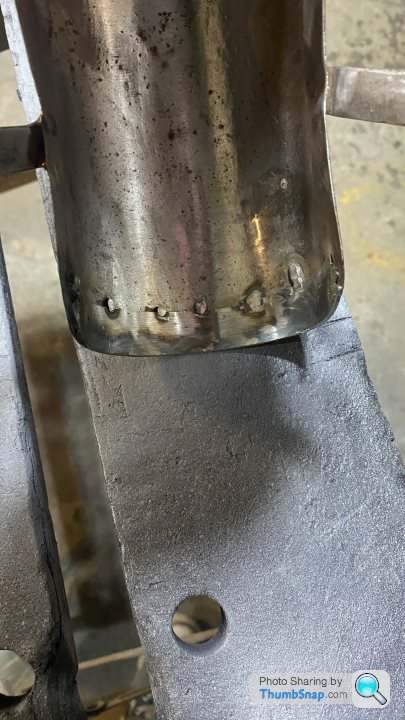
This bike came with a ‘regular’ Amal-style twistgrip, but that’s not right. One of the few shared parts with the Welbike was the throttle, which has a fitting welded on to the handlebars for the cable. I could see where it had had one originally and was ground off, so remade/reinstated it. Pic as how it should be from Lydia, and the replacement on Frankie.

I felt Frankie’s fuel tank was beyond saving…well OK, nothing’s really beyond saving but I’d have had to cut the bottom out, remake it, and do some panel-beating on the rest, and I could get a replica relatively cheaply from India (after a bit of haggling). There’s quite a good video on PH somewhere of them bashing out tanks with very rudimentary tools, but I digress. Claimed to be primed ready to paint, but a finish like a choppy sea, so a lot of prep work required. But the fittings were the wrong size and/or so poorly threaded it needed a bit of attention too, and I had to make up a new cross-pipe to suit the Indian-made threads.

Think seat, and you typically think seat pan and a but of foam. Not so on olde-worlde saddles. Cleaned-up and ready for paint, but just how many parts for a seat!

Ready for the cover; I got an upholsterer to make a new cover based on the old one; I think the only thing on the restoration/rebuild I didn’t do myself.

Then on to the exhaust and tail pipe. Luckily I’d managed to pick up the silencer can thingy, but I couldn’t get the alloy manifold that should bolt to the barrel that the pipe should go into so I had to make the pipe with the flange as part of it. I did try bending the pipe first, but even filled with sand I only ever managed to crimp it so got hold of some bends, and with a bit of chopping and welding we have a pipe that fits.
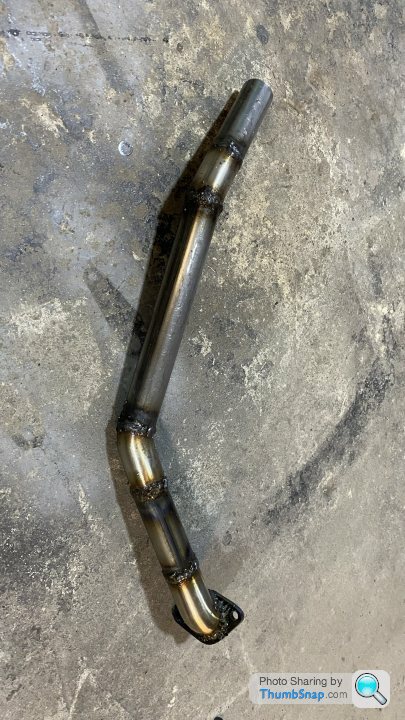
And this will be the tail pipe.

And so a complete system that’s a reasonable approximation of the factory system.

I’ve been trying since I got it to get the correct small levers for it – front brake and clutch. I’ve looked at various auto jumbles and on line, but all I can come up with is standard motorcycle sized levers. So in the end I gave up and looked for levers that were all alloy and not chromed so I could cut them down and polish them. So ended up with a pair of big Docherty levers – as per the top lever. Bottom lever is what it should be off Lydia, and the middle is my best effort cutting, filing and polishing the big lever. Not exactly correct, but of the right scale.

Made up new control cables and various other bits and pieces and was all bright-eyed and bushy-tailed to get it fired-up. Only it didn’t bloody run. Eventually I did get it fired-up, but only off a cordless drill on the engine sprocket bolt, and it would only run at high revs/wide-open throttle. Grrrr. I diagnosed probably the crankshaft oil seal so it would be motor out and apart again. It looked fine when I had the motor apart and so being a cheapskate I had left it. Toys duly thrown out of toybox and Frankie consigned to a corner of the garage, maybe until next winter.
I diagnosed probably the crankshaft oil seal so it would be motor out and apart again. It looked fine when I had the motor apart and so being a cheapskate I had left it. Toys duly thrown out of toybox and Frankie consigned to a corner of the garage, maybe until next winter. 
But the weather of late hasn’t been great, so I decided to get back on the case a couple of weeks back. The good news with these wee bikes is it only takes a couple of house to get the motor out and strip it down, and a couple of hours to put it back together and back in the frame. And this time I replaced every seal and bearing, hopefully to save future tear-downs.
…and the bloody thing still didn’t start; exactly the same as before. I’d put new coils in the mag and it was getting a great spark, so suspicion fell on the carb. The Mk1 motor (like this one) should have an Amal 259 carb, but I just could not get one. But the Mk4 motor uses an Amal 359, and I managed to pick up a used 359 body. Showing my lack of Amal knowledge, they look identical so I assumed the 359 superseded the 259. I got and put in the correct jets, needle and slide for the 259 and all seemed well. But the benefit of having another running Corgi was I was able to swap the carbs, and sure enough Frankie sprang into life immediately and sweetly. But the 2 carbs had identical jets, needle and slide and it was only after measuring the bores, I found the 359 has a bigger bore than the 259. Looks the same, but isn’t. Doh. That explained why it would only run at full throttle. With a bit more investigation I found that the 359 has different jets (but same needle and slide), so new jets acquired and fitted. And lo and behold it runs.
I’d put new coils in the mag and it was getting a great spark, so suspicion fell on the carb. The Mk1 motor (like this one) should have an Amal 259 carb, but I just could not get one. But the Mk4 motor uses an Amal 359, and I managed to pick up a used 359 body. Showing my lack of Amal knowledge, they look identical so I assumed the 359 superseded the 259. I got and put in the correct jets, needle and slide for the 259 and all seemed well. But the benefit of having another running Corgi was I was able to swap the carbs, and sure enough Frankie sprang into life immediately and sweetly. But the 2 carbs had identical jets, needle and slide and it was only after measuring the bores, I found the 359 has a bigger bore than the 259. Looks the same, but isn’t. Doh. That explained why it would only run at full throttle. With a bit more investigation I found that the 359 has different jets (but same needle and slide), so new jets acquired and fitted. And lo and behold it runs. 
But during this period of strip-down, rebuild and frigging about with carbs I was sufficiently pissed of to not take any pics.
But with a running bike, the last thing to do was spray the now-primed tank in my makeshift spray booth. …and I buggered that up slightly too. The finish came out really well, except for quite a few pock-marks. I only have the rudimentary standard water trap on my compressor and so I’m thinking either some water or compressor oil came down the line…that’s my theory anyway. It’ll need rubbed down and repainted at some point, but good enough for the time being. But a winter task lined-up.

So that’s it then…tank on and complete. Just got to see if I can get it registered with the DVLA so I can ride it.



Frankie and Lydia looking rather better than when I got them

...th...th...th...thats all folks.
Back to March then – finishing off some of the tinware repairs, the rear of the front mudguard was eaten away with rust, so a new section added.

This bike came with a ‘regular’ Amal-style twistgrip, but that’s not right. One of the few shared parts with the Welbike was the throttle, which has a fitting welded on to the handlebars for the cable. I could see where it had had one originally and was ground off, so remade/reinstated it. Pic as how it should be from Lydia, and the replacement on Frankie.

I felt Frankie’s fuel tank was beyond saving…well OK, nothing’s really beyond saving but I’d have had to cut the bottom out, remake it, and do some panel-beating on the rest, and I could get a replica relatively cheaply from India (after a bit of haggling). There’s quite a good video on PH somewhere of them bashing out tanks with very rudimentary tools, but I digress. Claimed to be primed ready to paint, but a finish like a choppy sea, so a lot of prep work required. But the fittings were the wrong size and/or so poorly threaded it needed a bit of attention too, and I had to make up a new cross-pipe to suit the Indian-made threads.

Think seat, and you typically think seat pan and a but of foam. Not so on olde-worlde saddles. Cleaned-up and ready for paint, but just how many parts for a seat!

Ready for the cover; I got an upholsterer to make a new cover based on the old one; I think the only thing on the restoration/rebuild I didn’t do myself.

Then on to the exhaust and tail pipe. Luckily I’d managed to pick up the silencer can thingy, but I couldn’t get the alloy manifold that should bolt to the barrel that the pipe should go into so I had to make the pipe with the flange as part of it. I did try bending the pipe first, but even filled with sand I only ever managed to crimp it so got hold of some bends, and with a bit of chopping and welding we have a pipe that fits.

And this will be the tail pipe.

And so a complete system that’s a reasonable approximation of the factory system.

I’ve been trying since I got it to get the correct small levers for it – front brake and clutch. I’ve looked at various auto jumbles and on line, but all I can come up with is standard motorcycle sized levers. So in the end I gave up and looked for levers that were all alloy and not chromed so I could cut them down and polish them. So ended up with a pair of big Docherty levers – as per the top lever. Bottom lever is what it should be off Lydia, and the middle is my best effort cutting, filing and polishing the big lever. Not exactly correct, but of the right scale.

Made up new control cables and various other bits and pieces and was all bright-eyed and bushy-tailed to get it fired-up. Only it didn’t bloody run. Eventually I did get it fired-up, but only off a cordless drill on the engine sprocket bolt, and it would only run at high revs/wide-open throttle. Grrrr.
 I diagnosed probably the crankshaft oil seal so it would be motor out and apart again. It looked fine when I had the motor apart and so being a cheapskate I had left it. Toys duly thrown out of toybox and Frankie consigned to a corner of the garage, maybe until next winter.
I diagnosed probably the crankshaft oil seal so it would be motor out and apart again. It looked fine when I had the motor apart and so being a cheapskate I had left it. Toys duly thrown out of toybox and Frankie consigned to a corner of the garage, maybe until next winter. 
But the weather of late hasn’t been great, so I decided to get back on the case a couple of weeks back. The good news with these wee bikes is it only takes a couple of house to get the motor out and strip it down, and a couple of hours to put it back together and back in the frame. And this time I replaced every seal and bearing, hopefully to save future tear-downs.
…and the bloody thing still didn’t start; exactly the same as before.
 I’d put new coils in the mag and it was getting a great spark, so suspicion fell on the carb. The Mk1 motor (like this one) should have an Amal 259 carb, but I just could not get one. But the Mk4 motor uses an Amal 359, and I managed to pick up a used 359 body. Showing my lack of Amal knowledge, they look identical so I assumed the 359 superseded the 259. I got and put in the correct jets, needle and slide for the 259 and all seemed well. But the benefit of having another running Corgi was I was able to swap the carbs, and sure enough Frankie sprang into life immediately and sweetly. But the 2 carbs had identical jets, needle and slide and it was only after measuring the bores, I found the 359 has a bigger bore than the 259. Looks the same, but isn’t. Doh. That explained why it would only run at full throttle. With a bit more investigation I found that the 359 has different jets (but same needle and slide), so new jets acquired and fitted. And lo and behold it runs.
I’d put new coils in the mag and it was getting a great spark, so suspicion fell on the carb. The Mk1 motor (like this one) should have an Amal 259 carb, but I just could not get one. But the Mk4 motor uses an Amal 359, and I managed to pick up a used 359 body. Showing my lack of Amal knowledge, they look identical so I assumed the 359 superseded the 259. I got and put in the correct jets, needle and slide for the 259 and all seemed well. But the benefit of having another running Corgi was I was able to swap the carbs, and sure enough Frankie sprang into life immediately and sweetly. But the 2 carbs had identical jets, needle and slide and it was only after measuring the bores, I found the 359 has a bigger bore than the 259. Looks the same, but isn’t. Doh. That explained why it would only run at full throttle. With a bit more investigation I found that the 359 has different jets (but same needle and slide), so new jets acquired and fitted. And lo and behold it runs. 
But during this period of strip-down, rebuild and frigging about with carbs I was sufficiently pissed of to not take any pics.
But with a running bike, the last thing to do was spray the now-primed tank in my makeshift spray booth. …and I buggered that up slightly too. The finish came out really well, except for quite a few pock-marks. I only have the rudimentary standard water trap on my compressor and so I’m thinking either some water or compressor oil came down the line…that’s my theory anyway. It’ll need rubbed down and repainted at some point, but good enough for the time being. But a winter task lined-up.

So that’s it then…tank on and complete. Just got to see if I can get it registered with the DVLA so I can ride it.



Frankie and Lydia looking rather better than when I got them


...th...th...th...thats all folks.

Gassing Station | Biker Banter | Top of Page | What's New | My Stuff



